
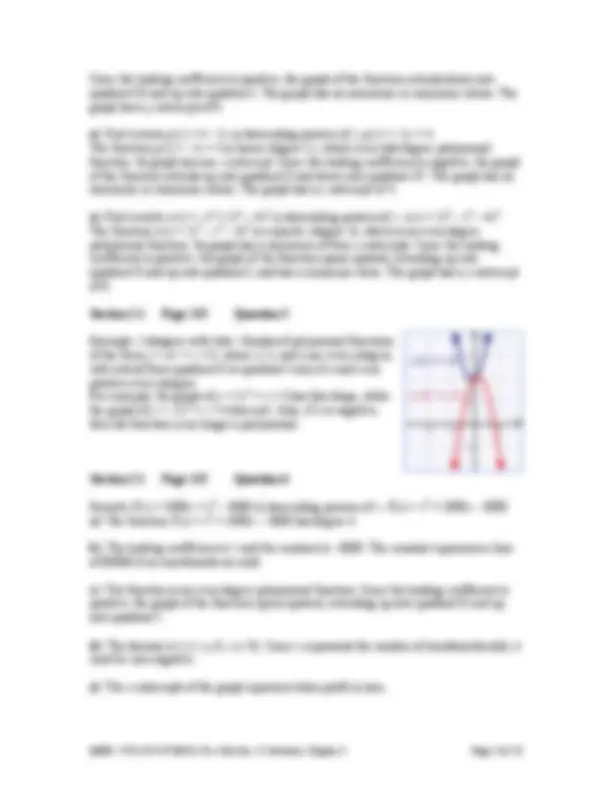

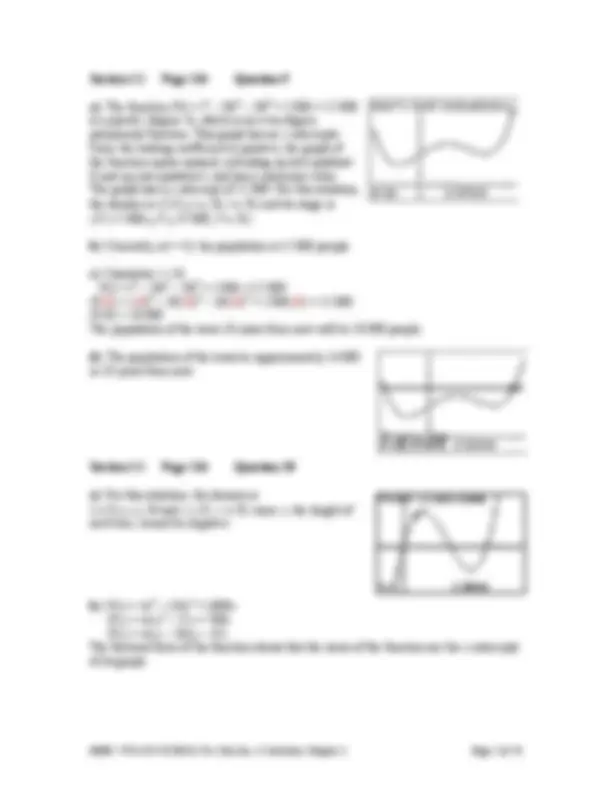
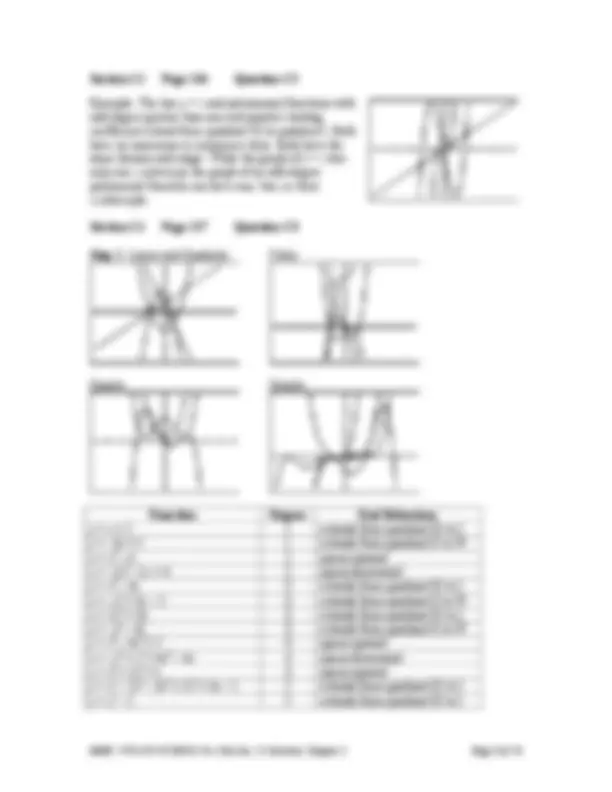
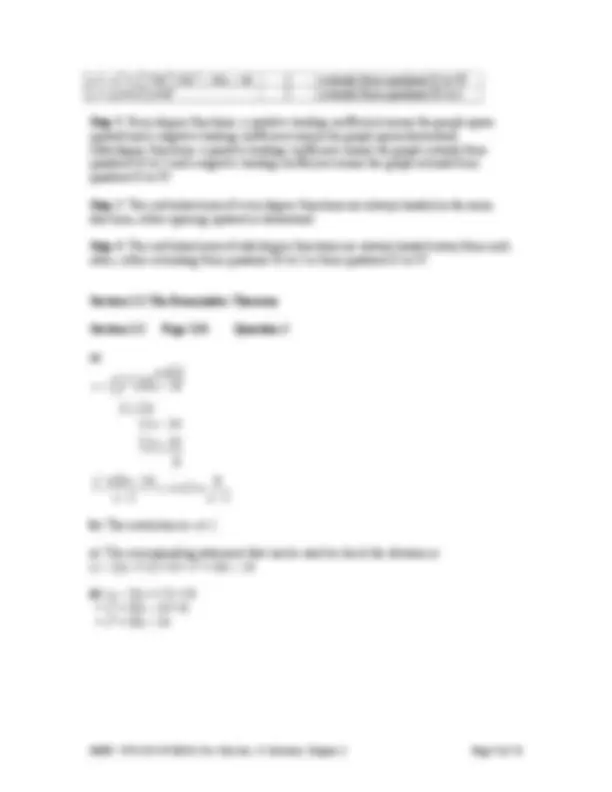
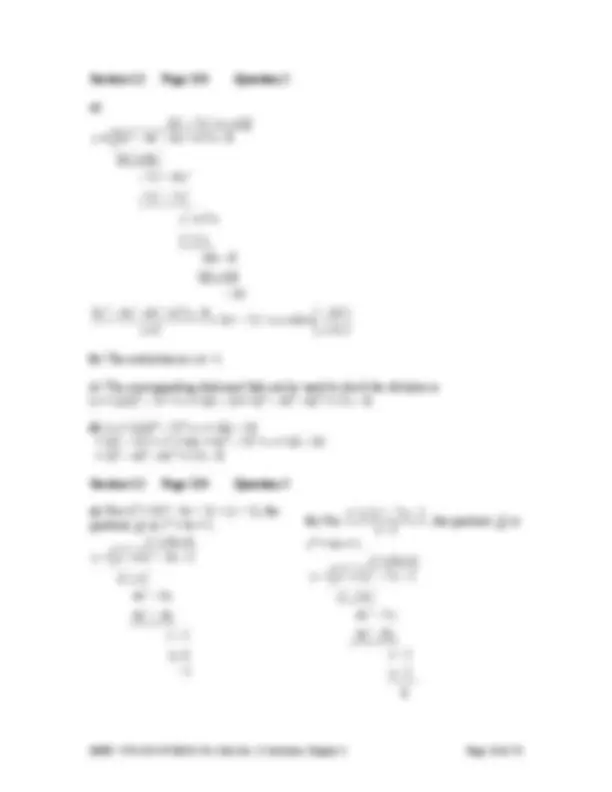
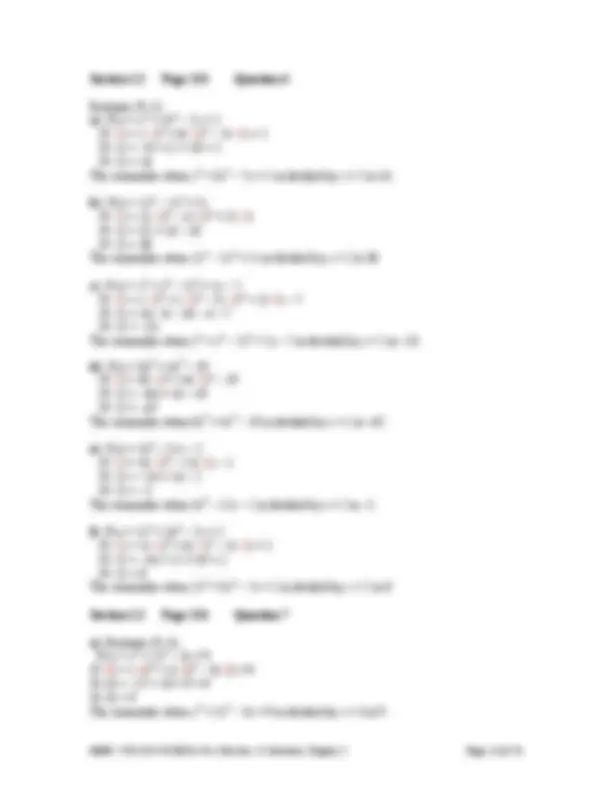

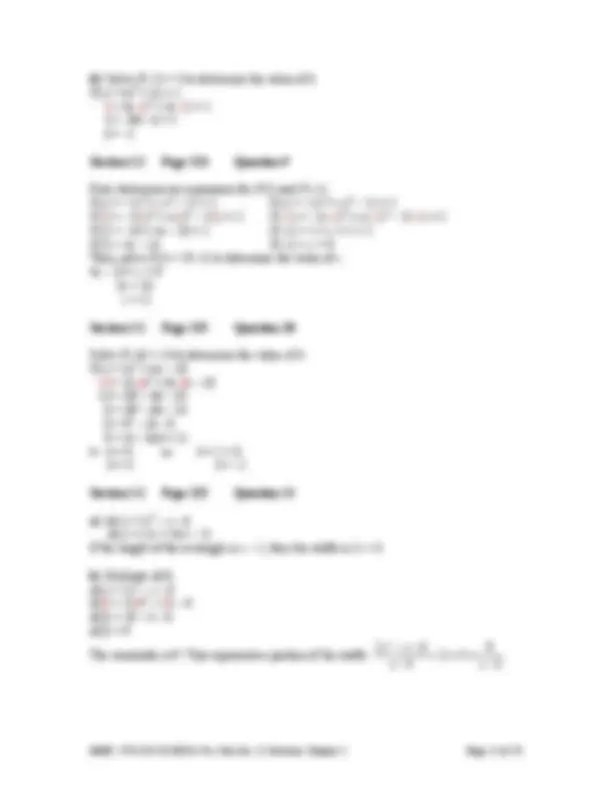
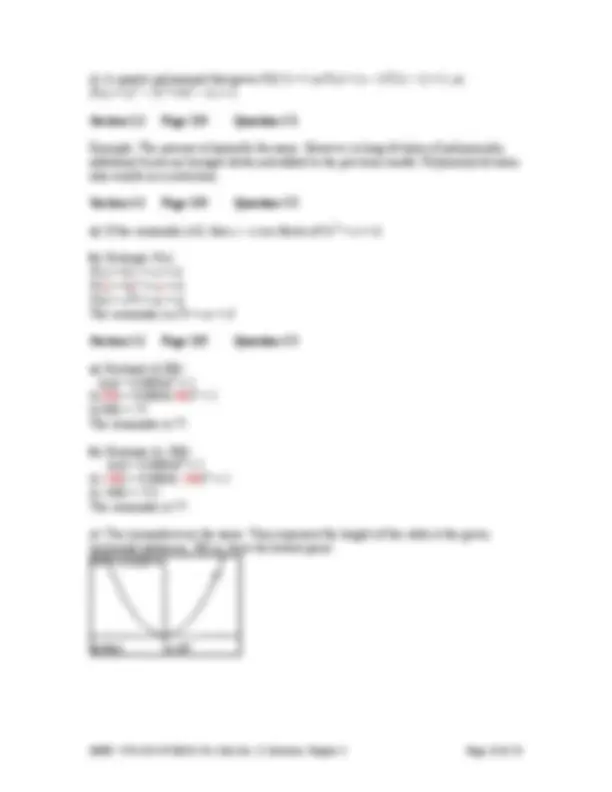
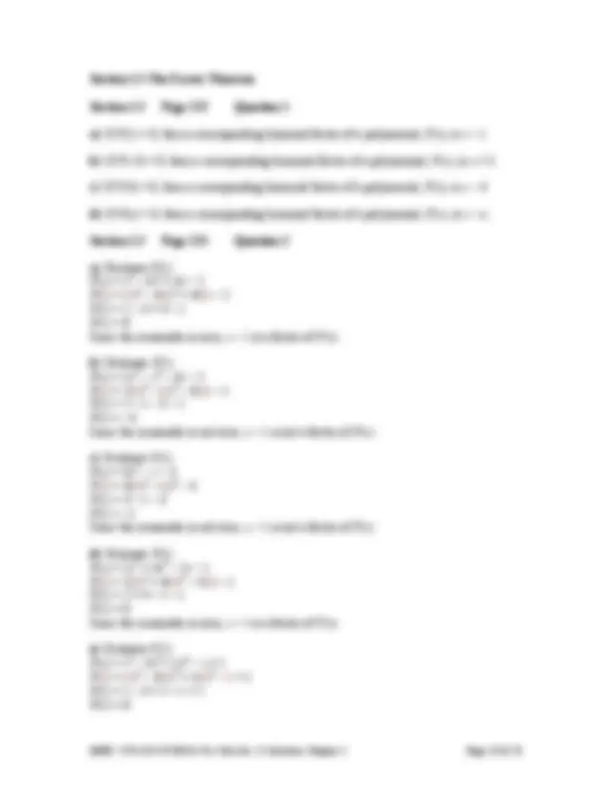
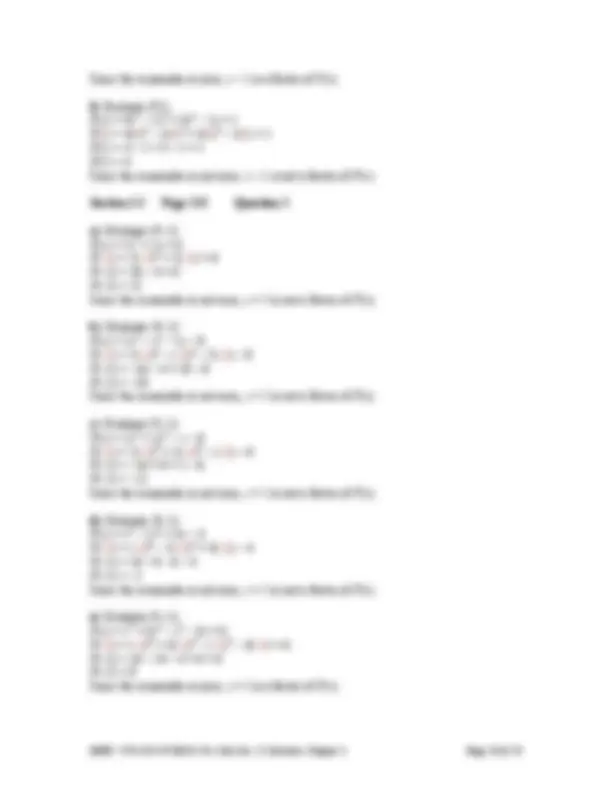
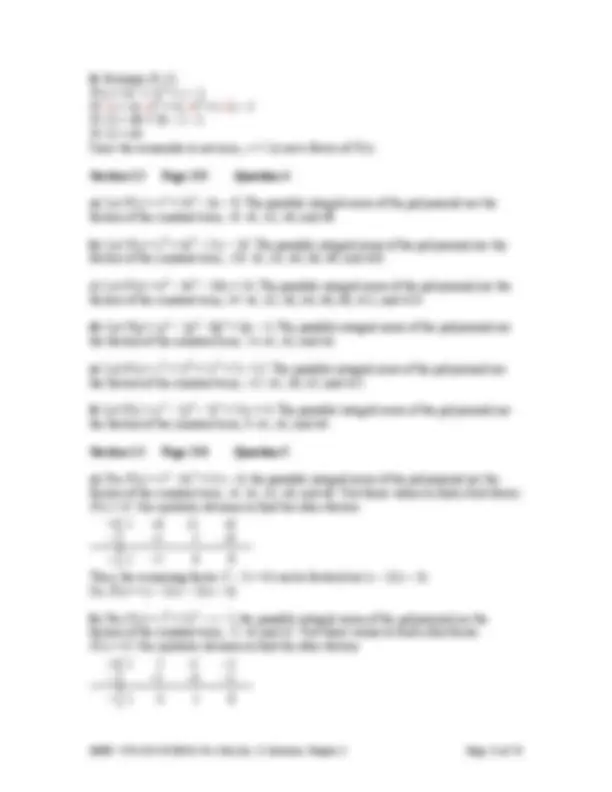
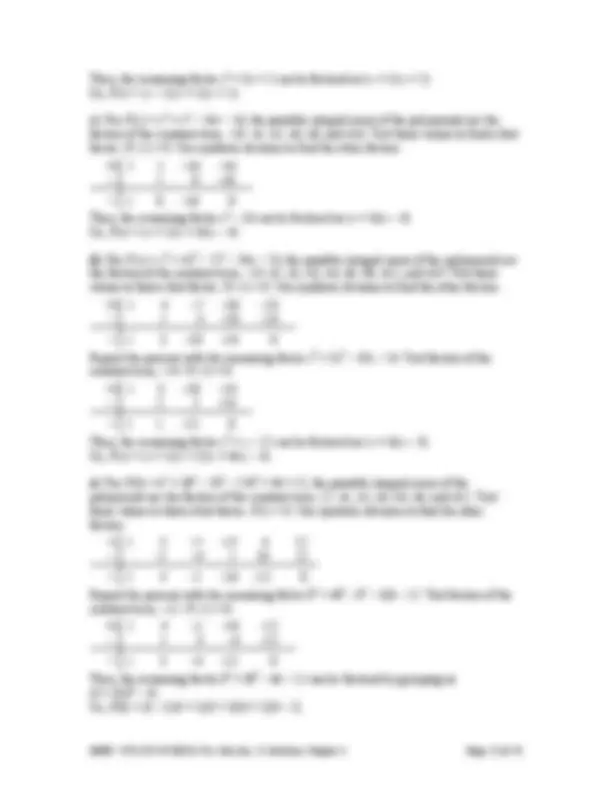
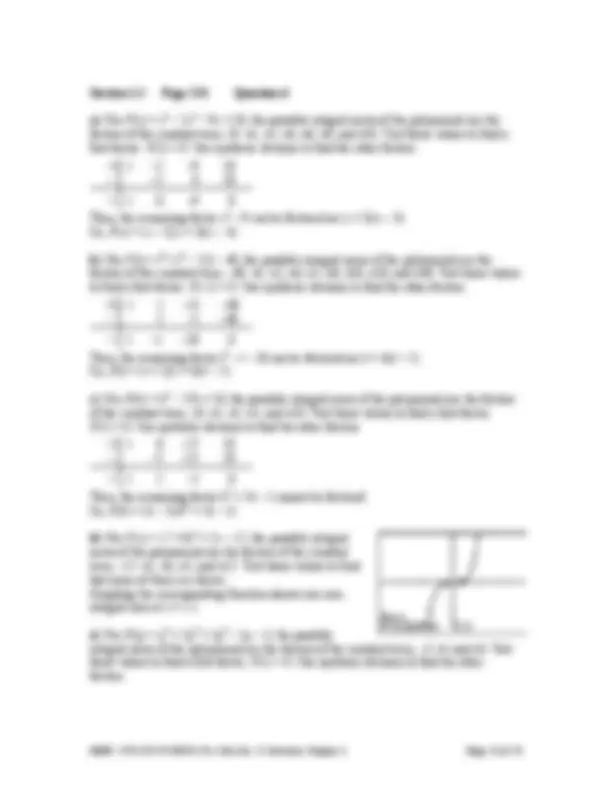
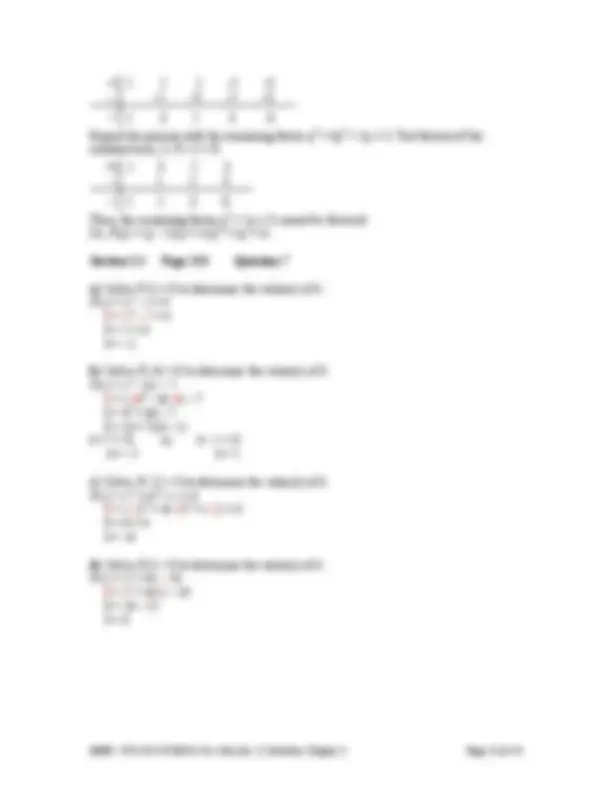
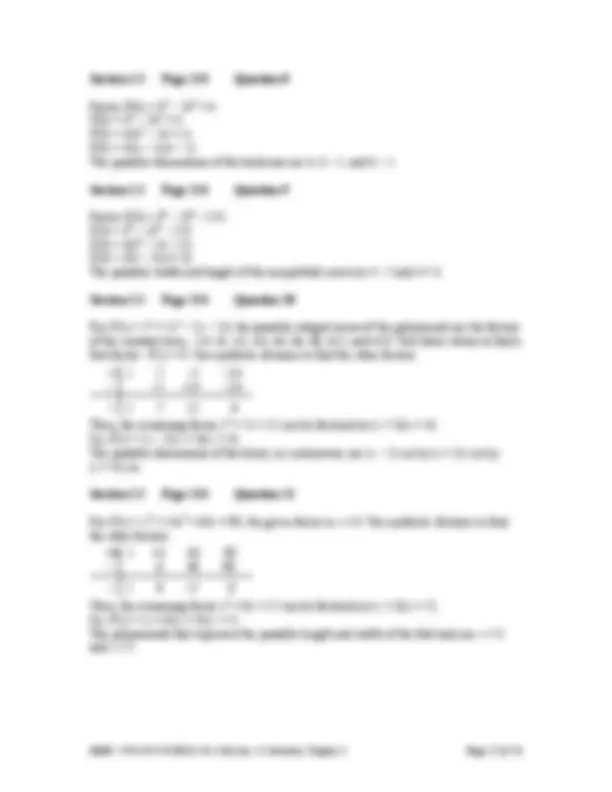
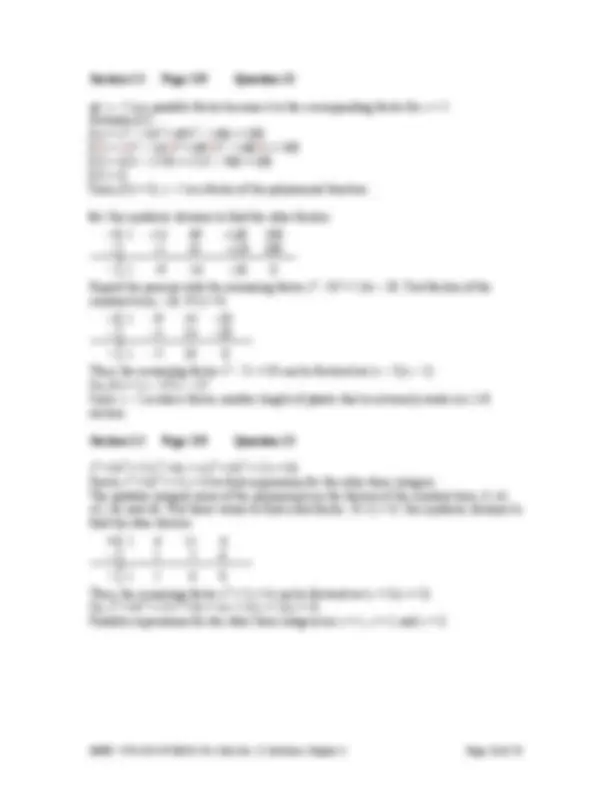
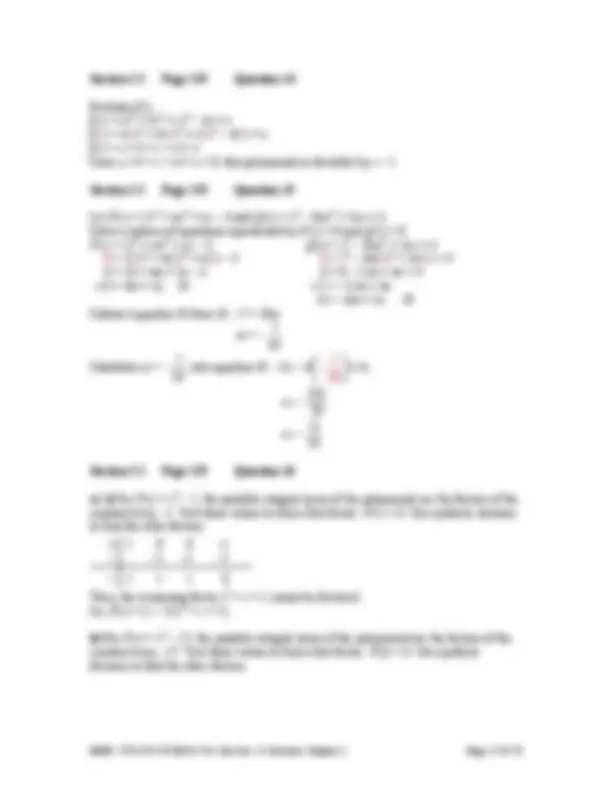
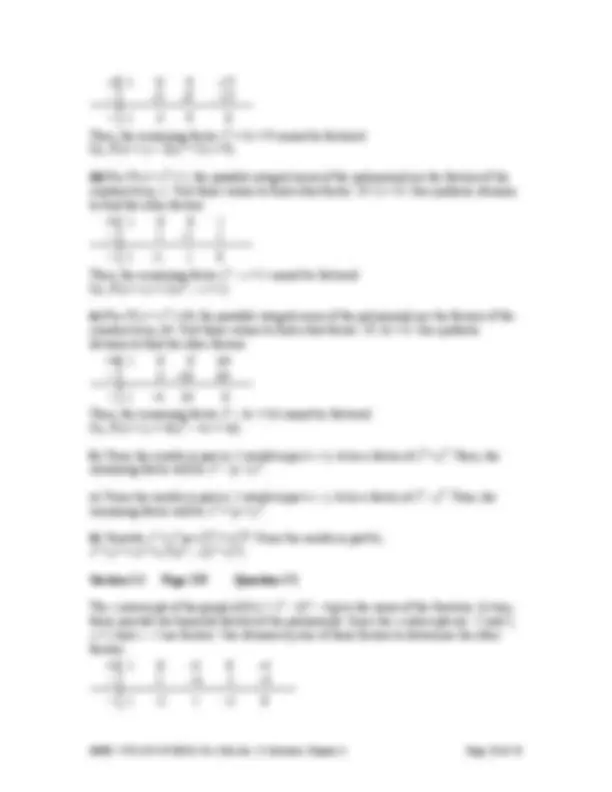
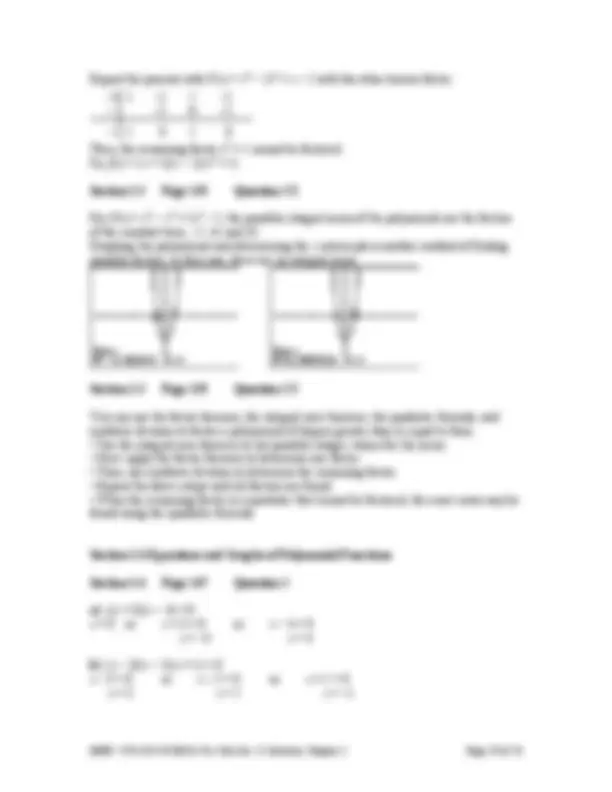
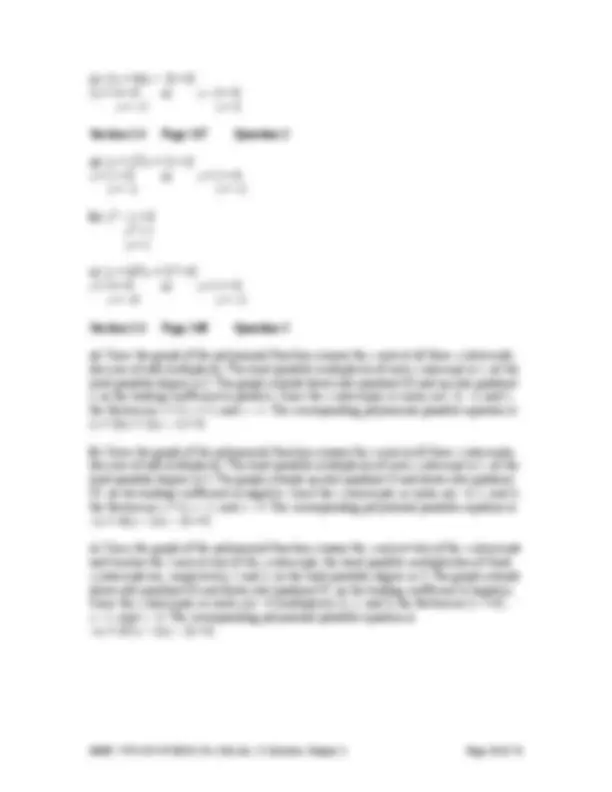

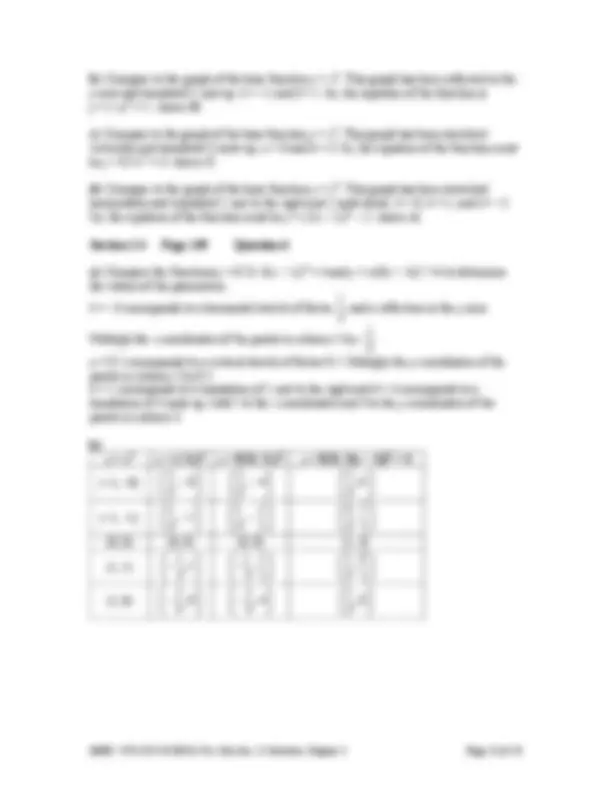
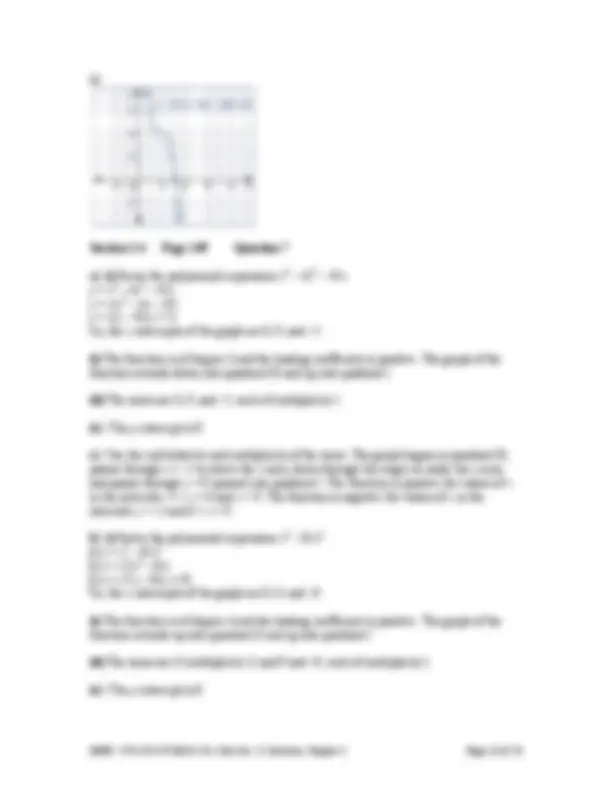
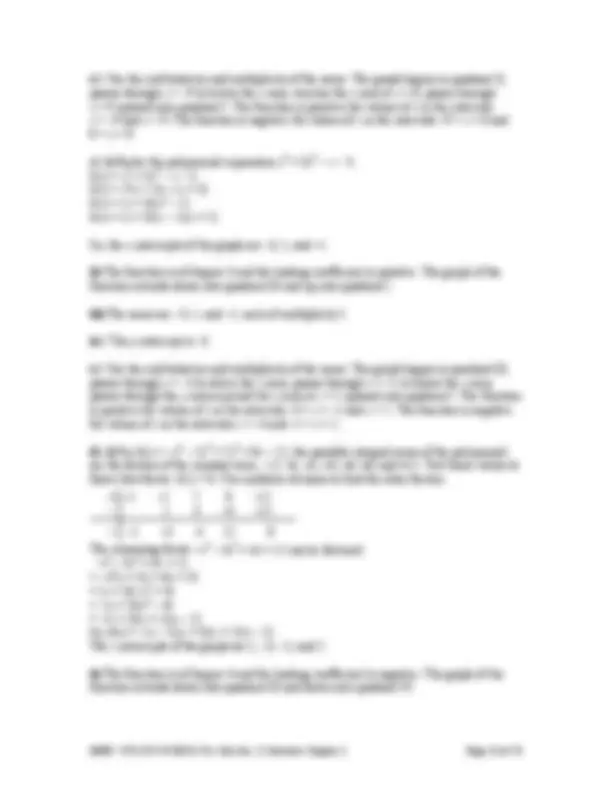
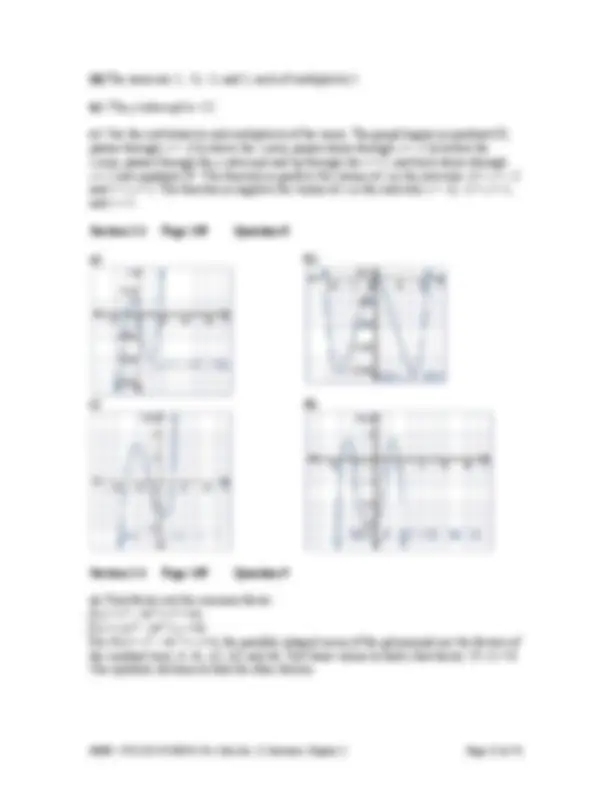
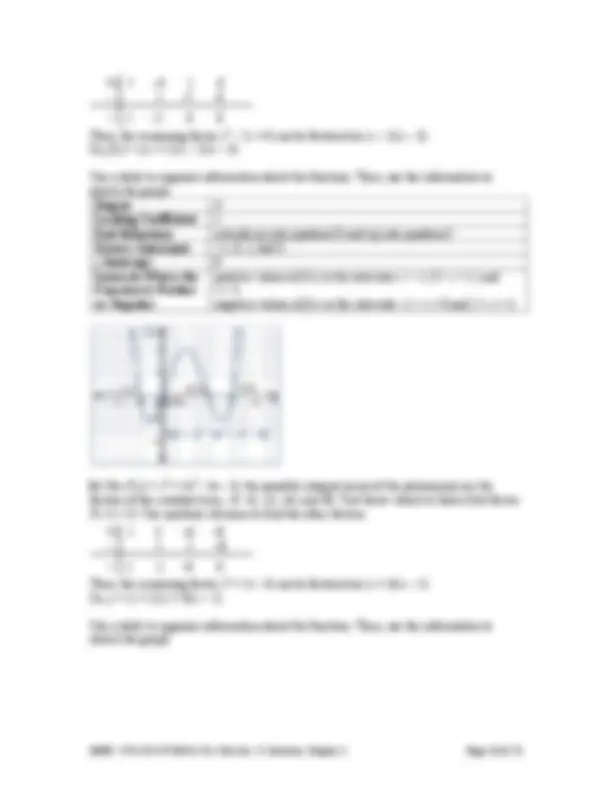
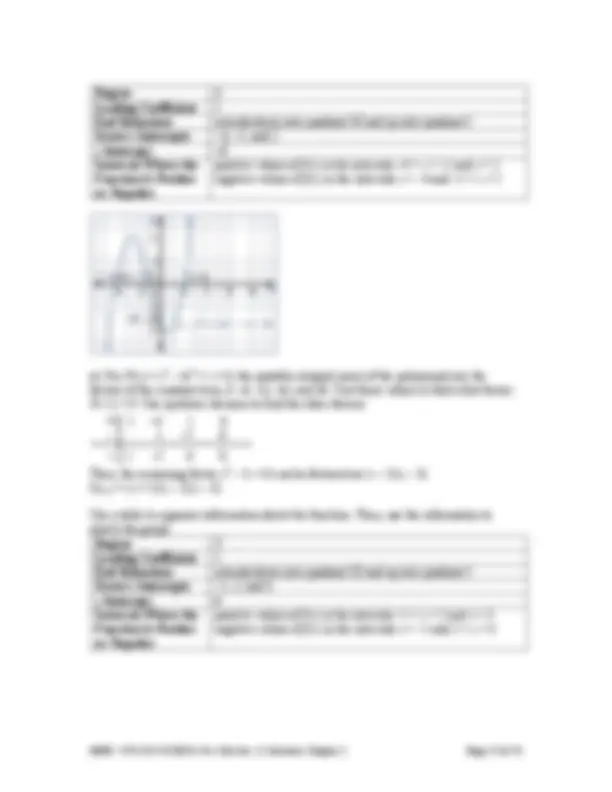
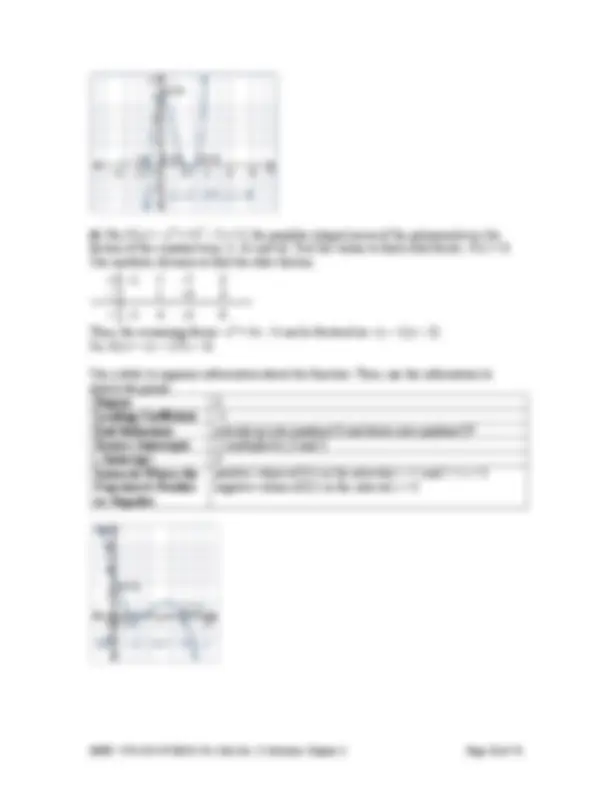
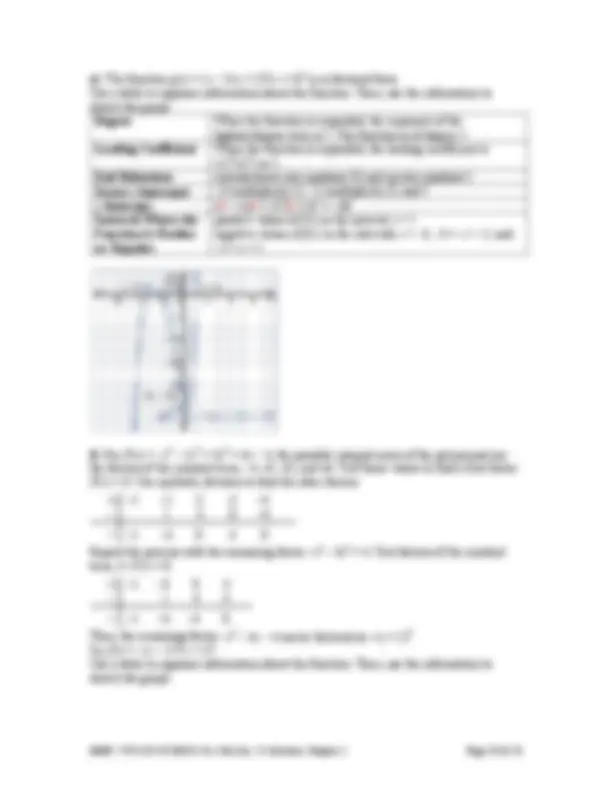
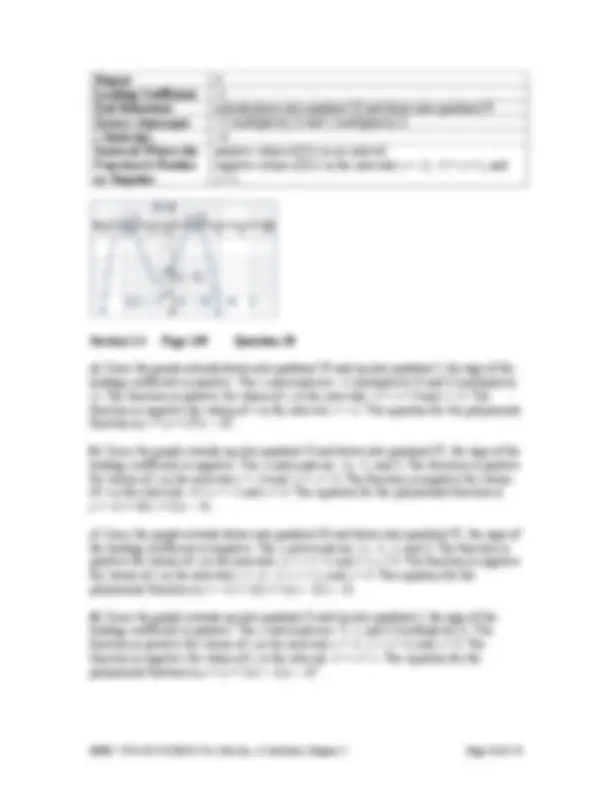
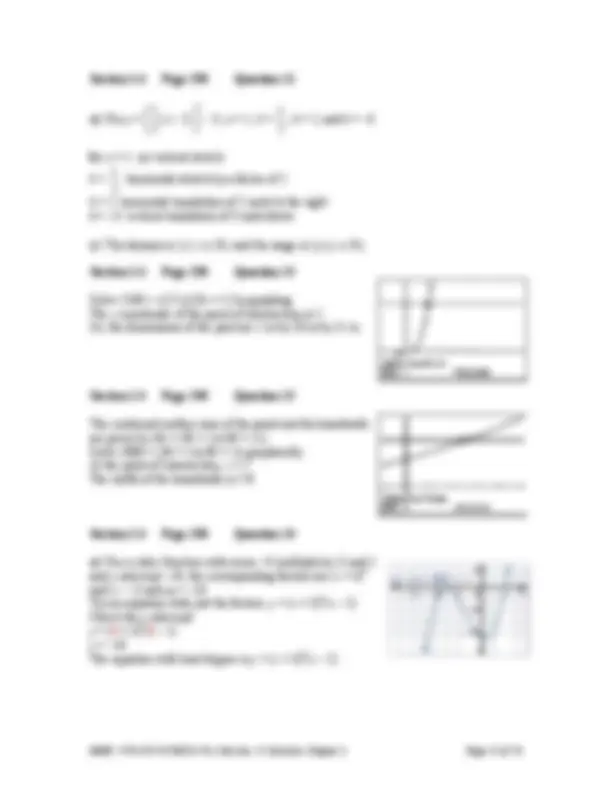

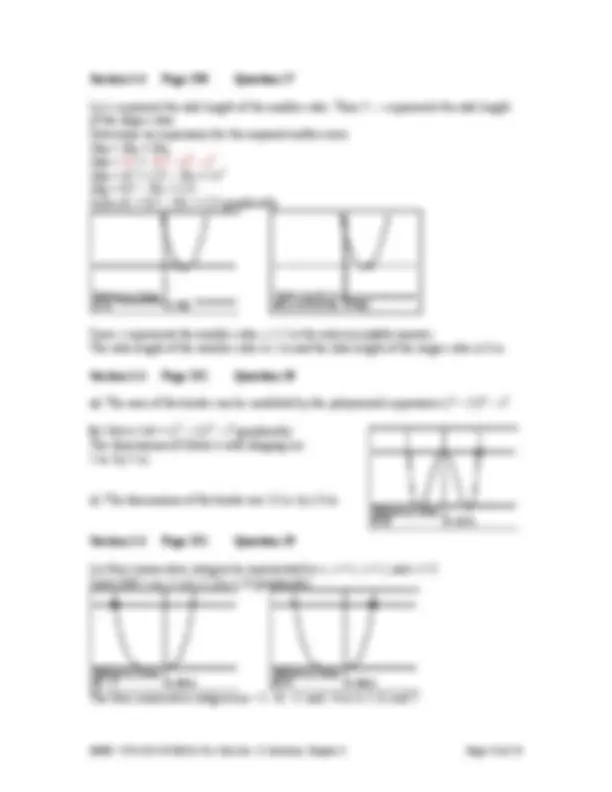
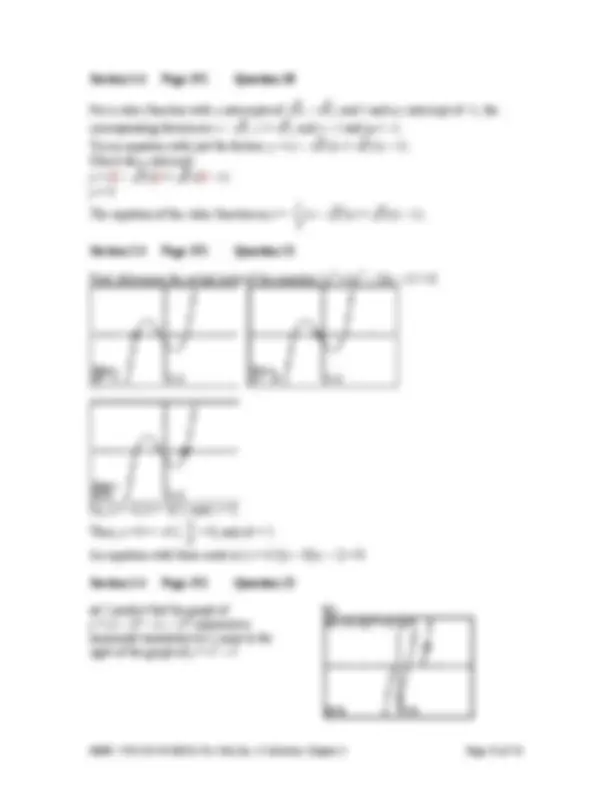
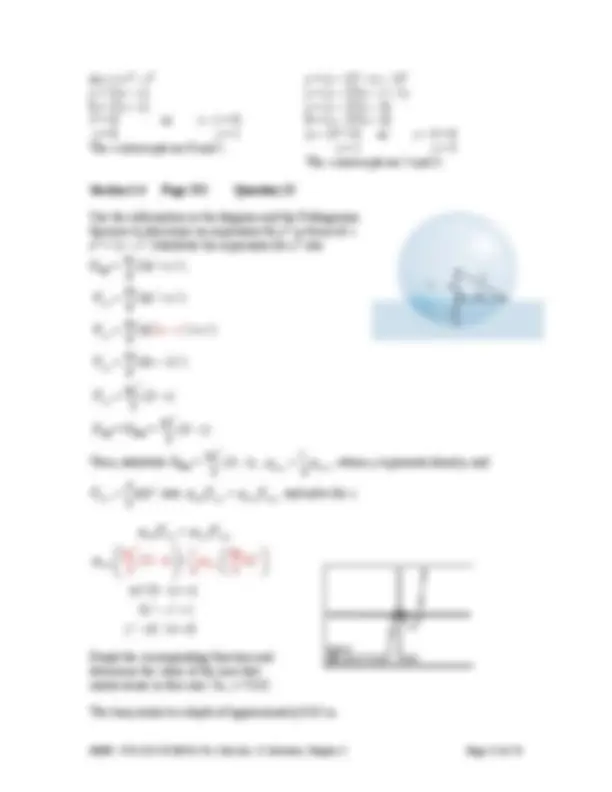
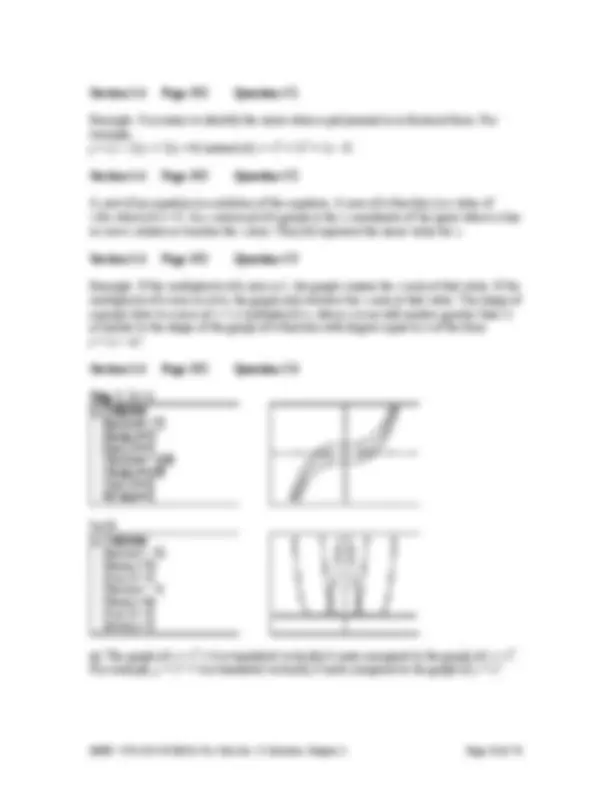

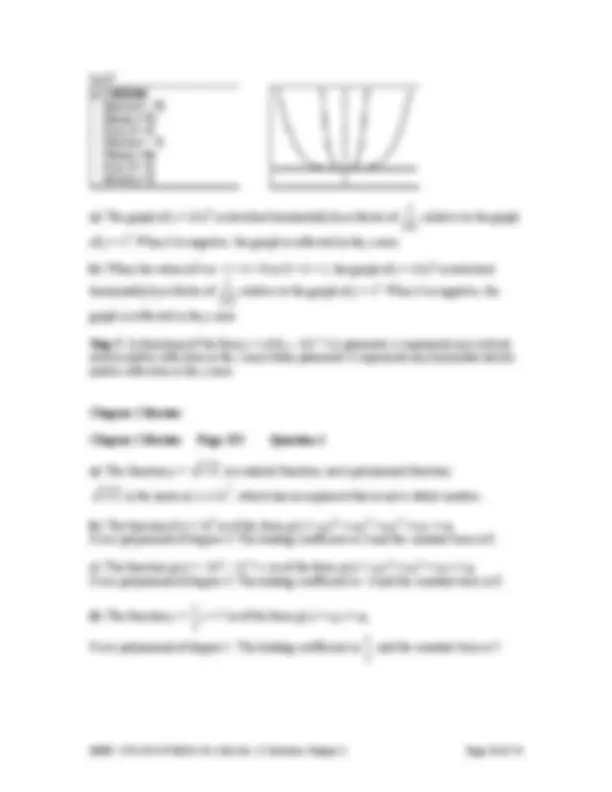
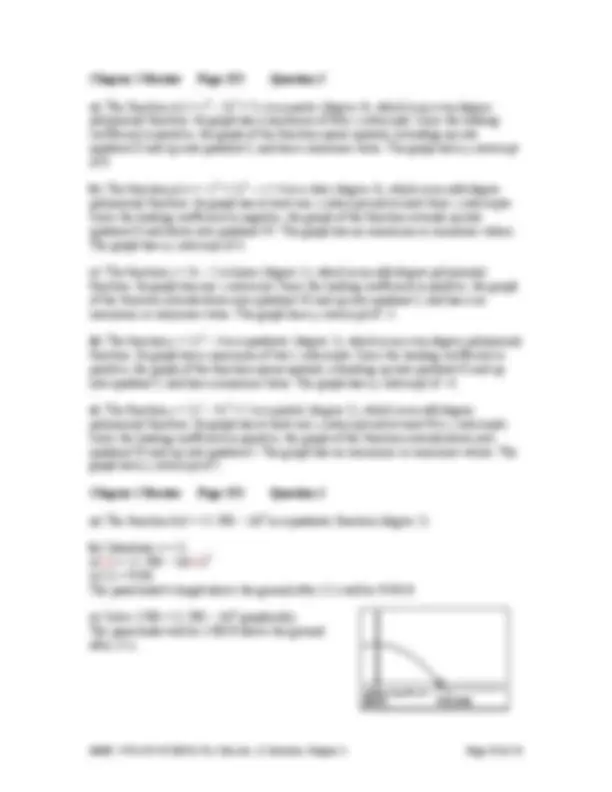
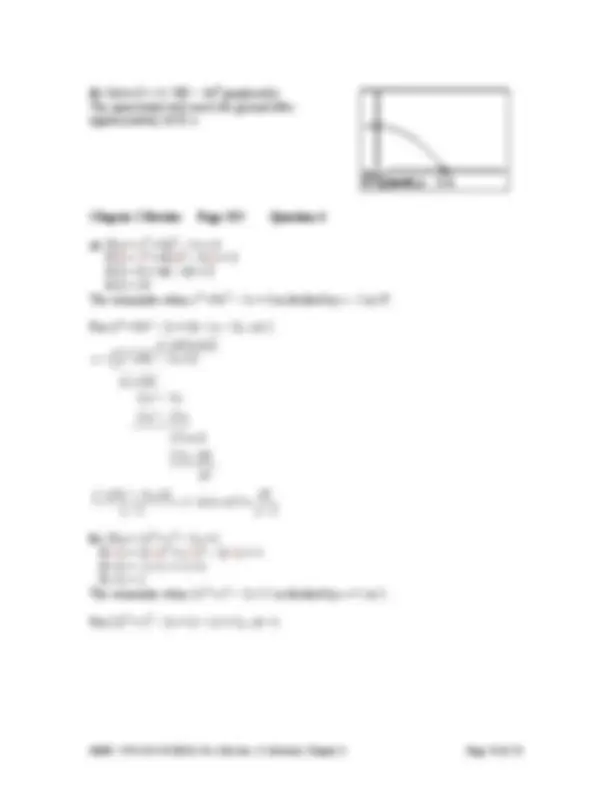
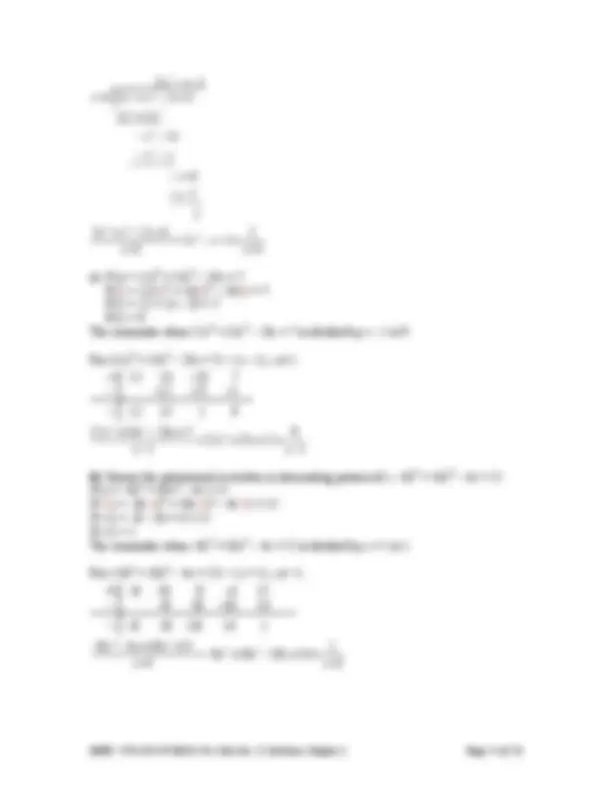
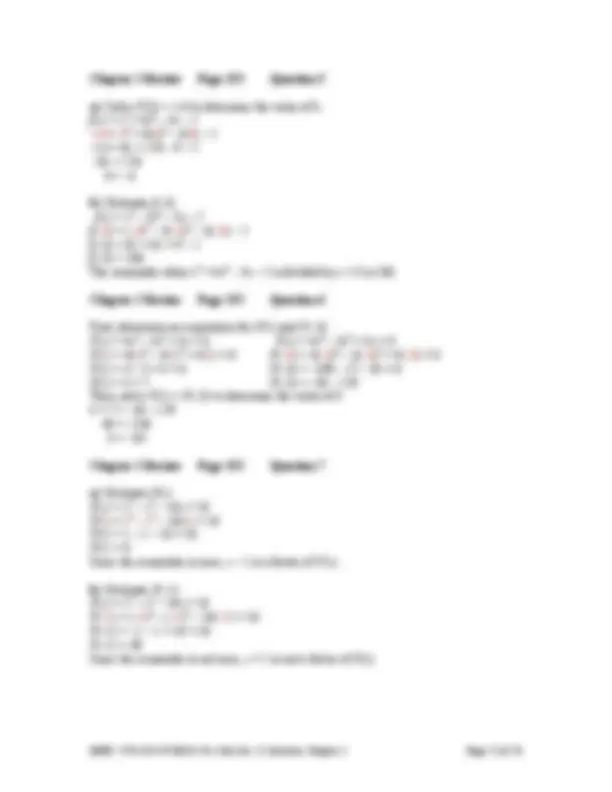
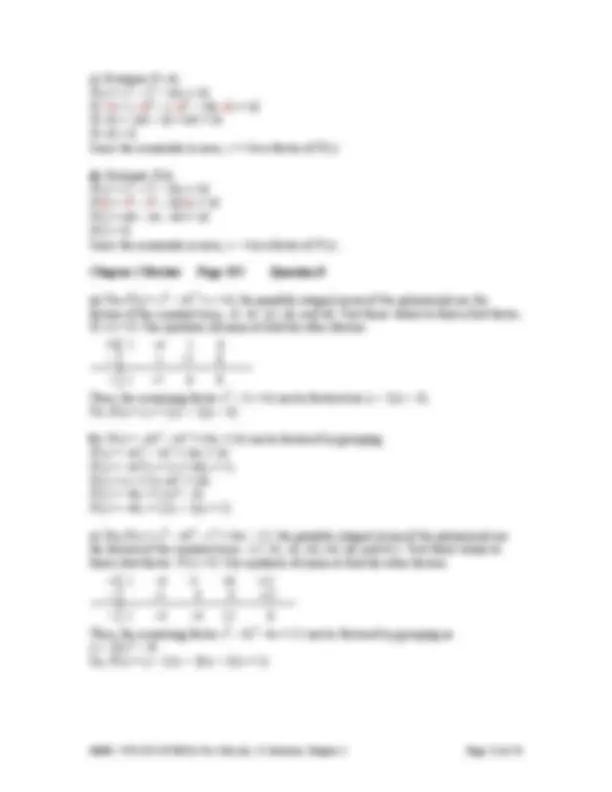
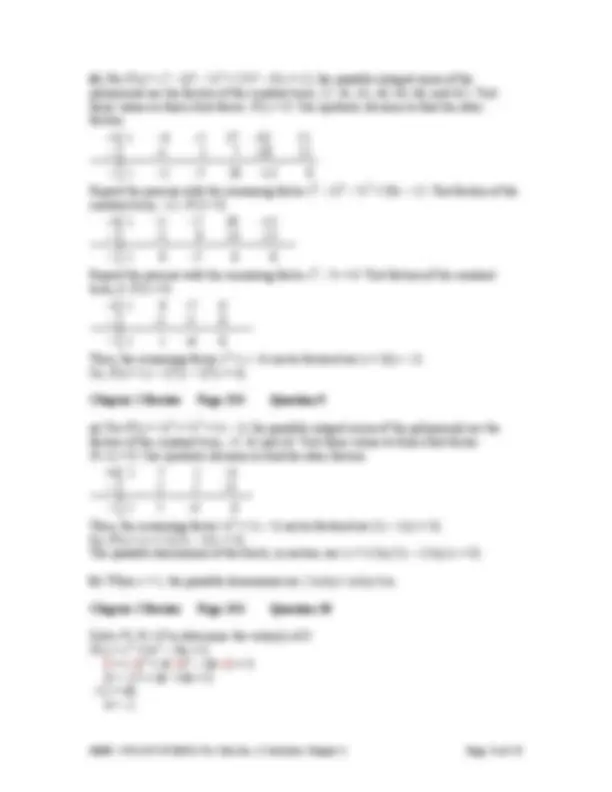
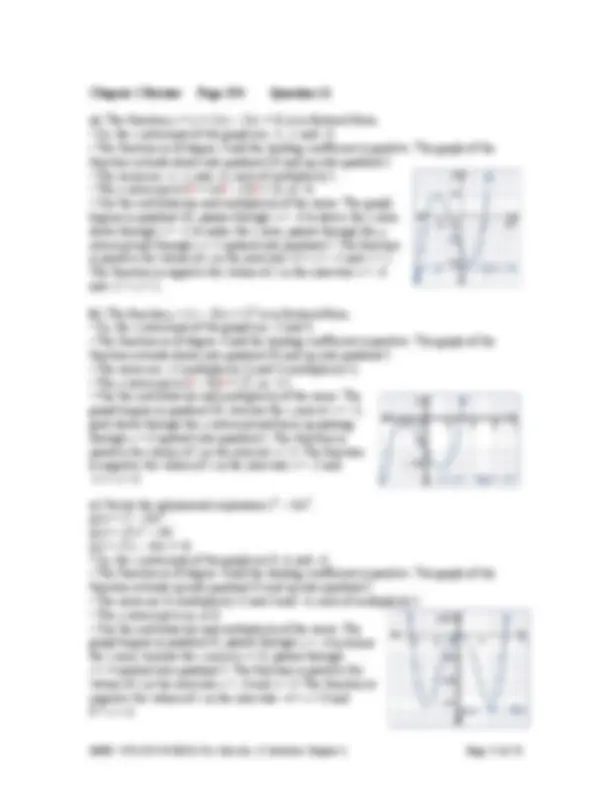
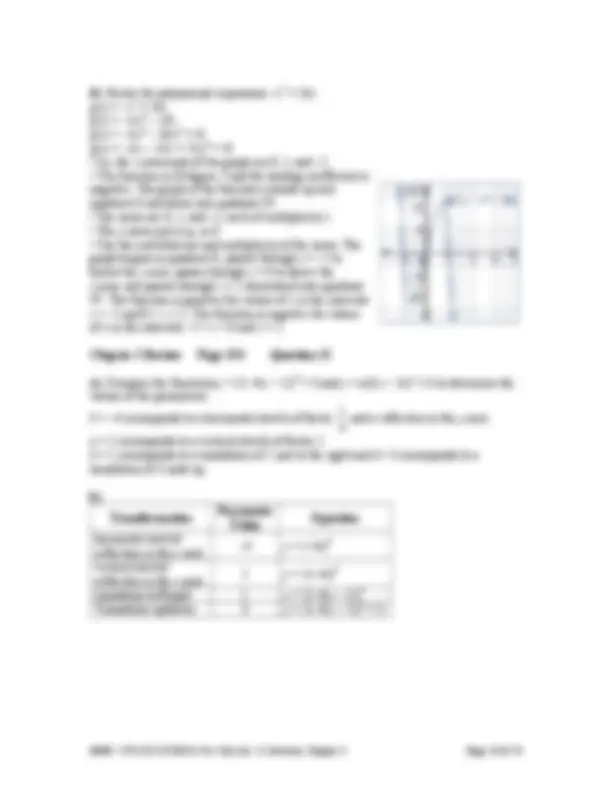
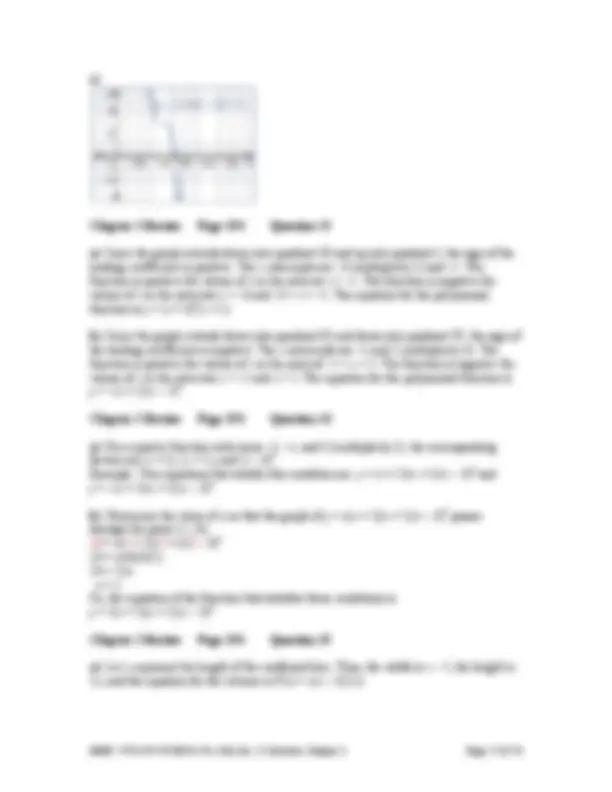
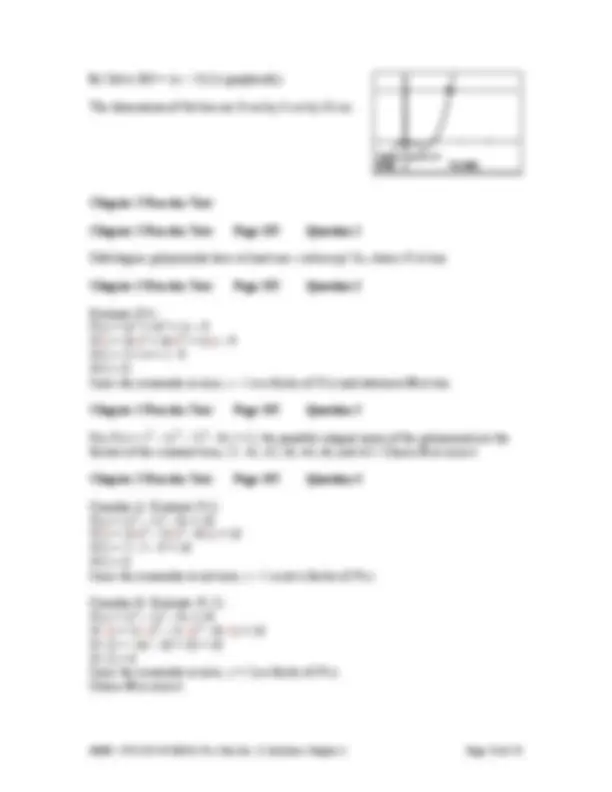
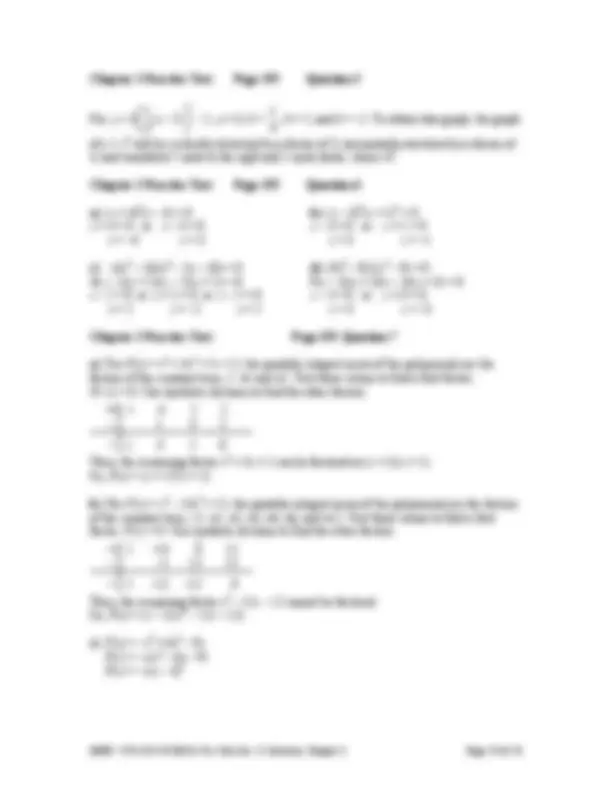
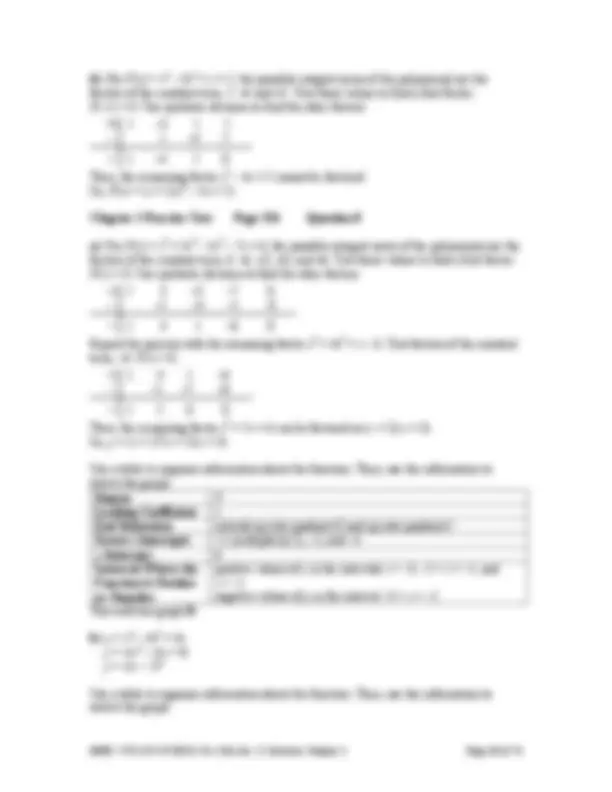
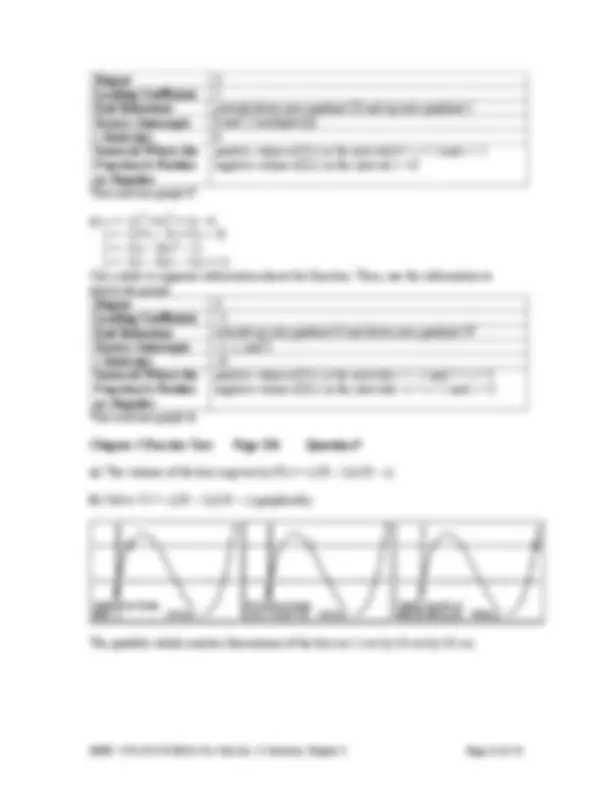
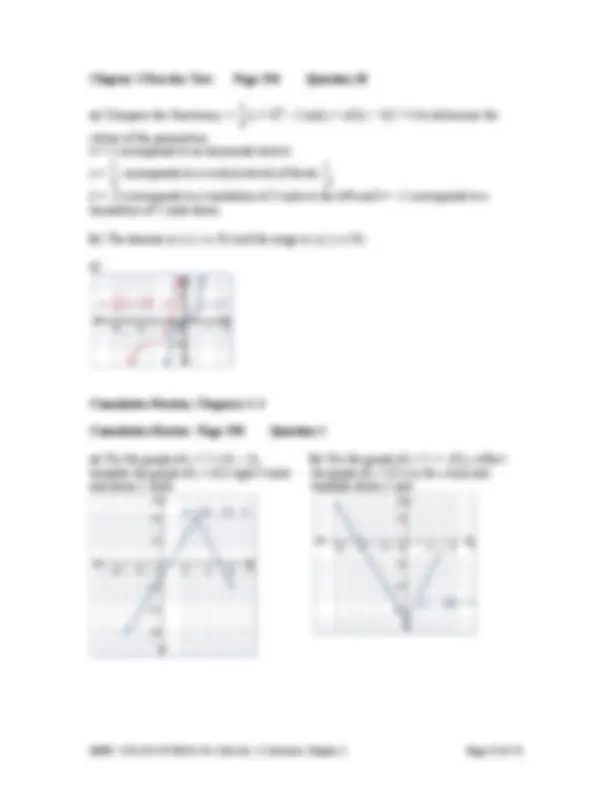
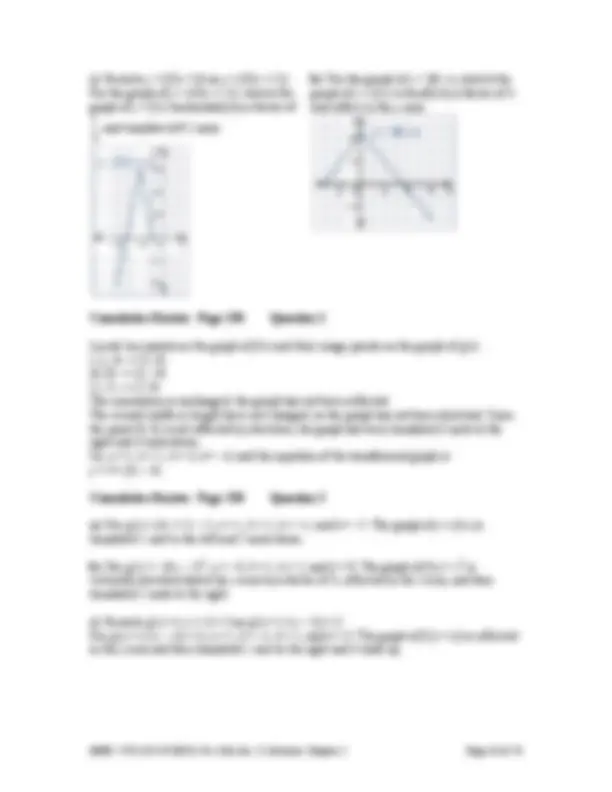
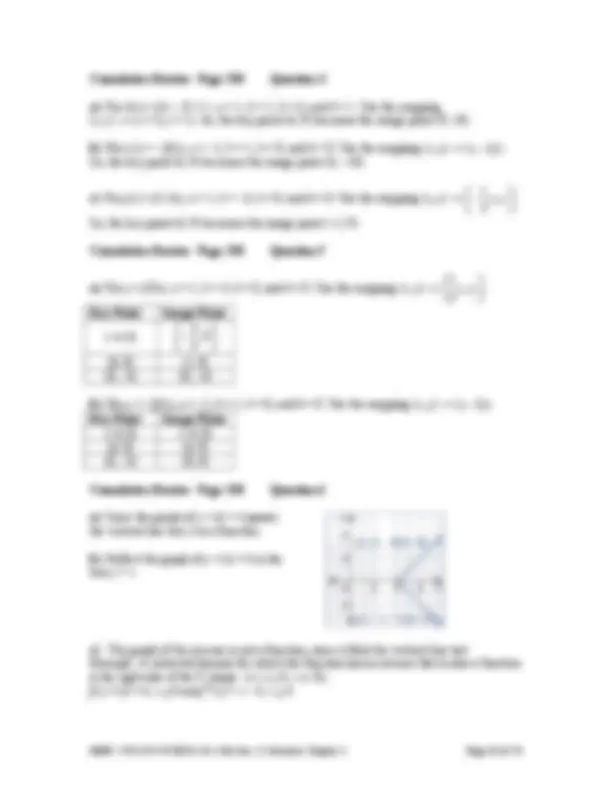
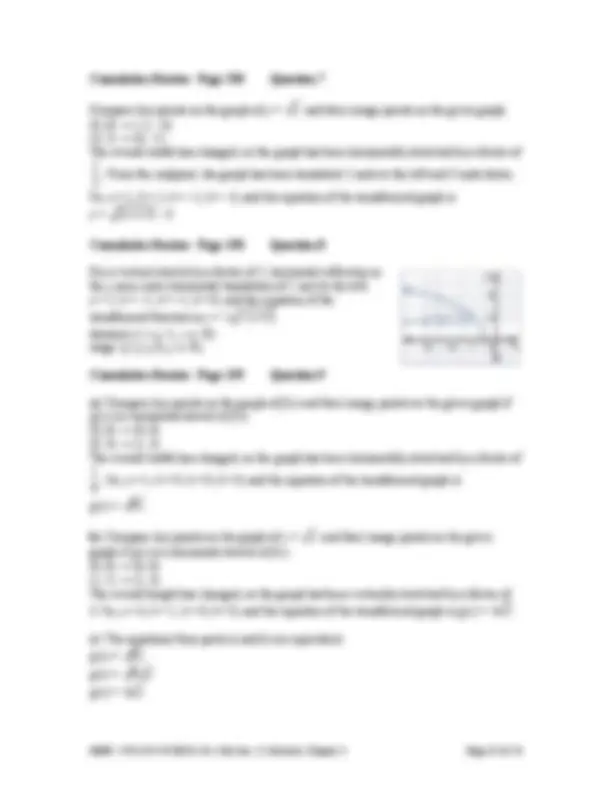
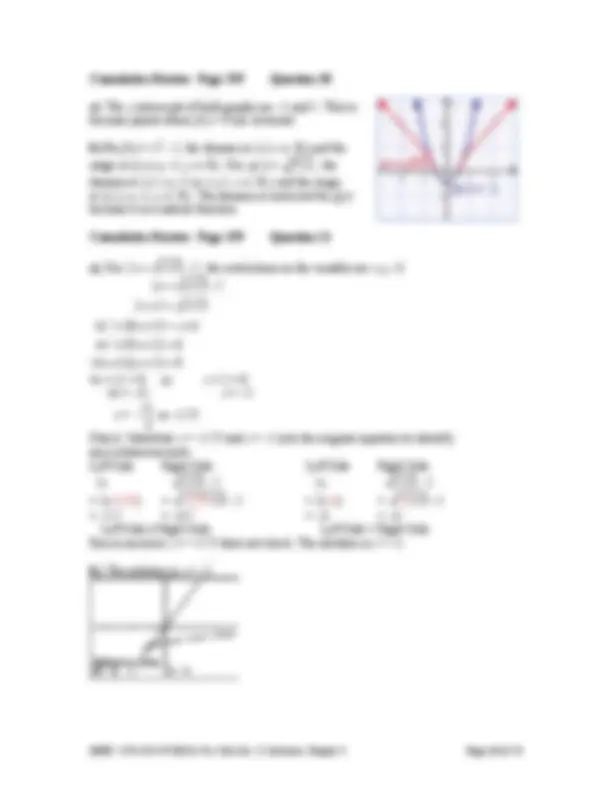
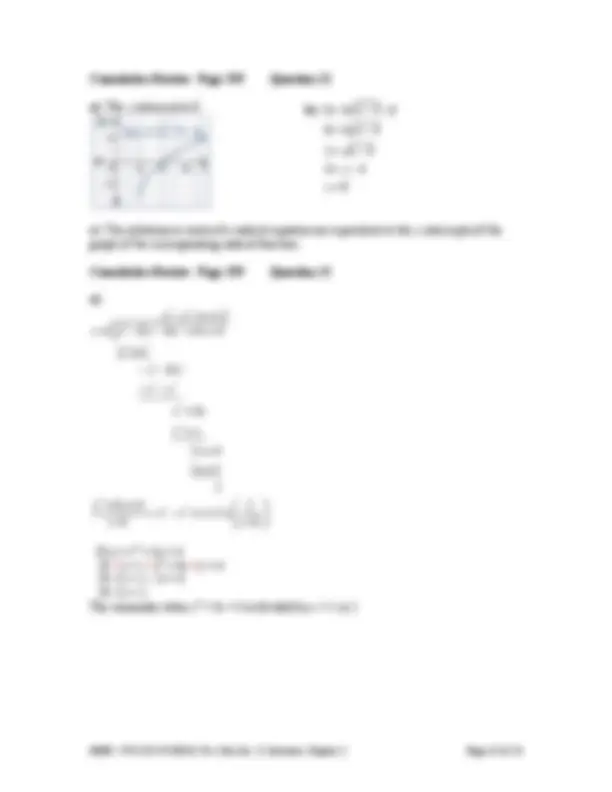
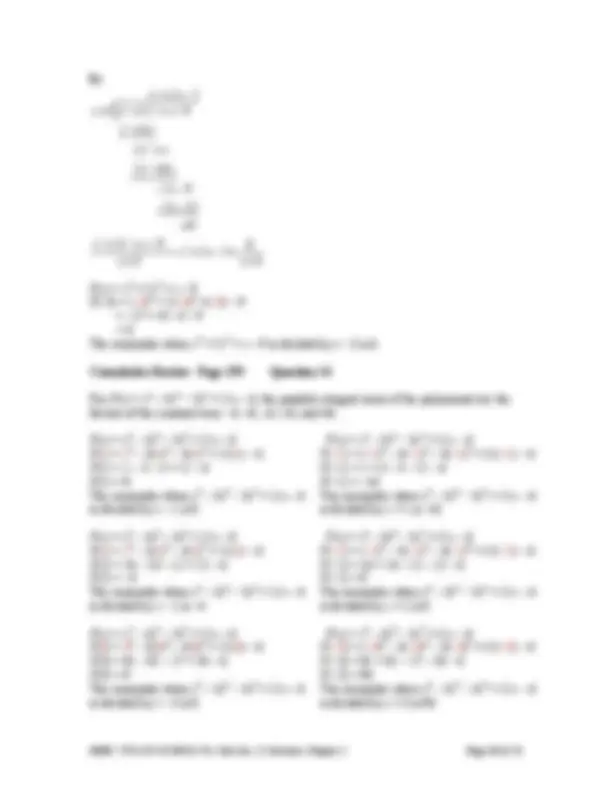
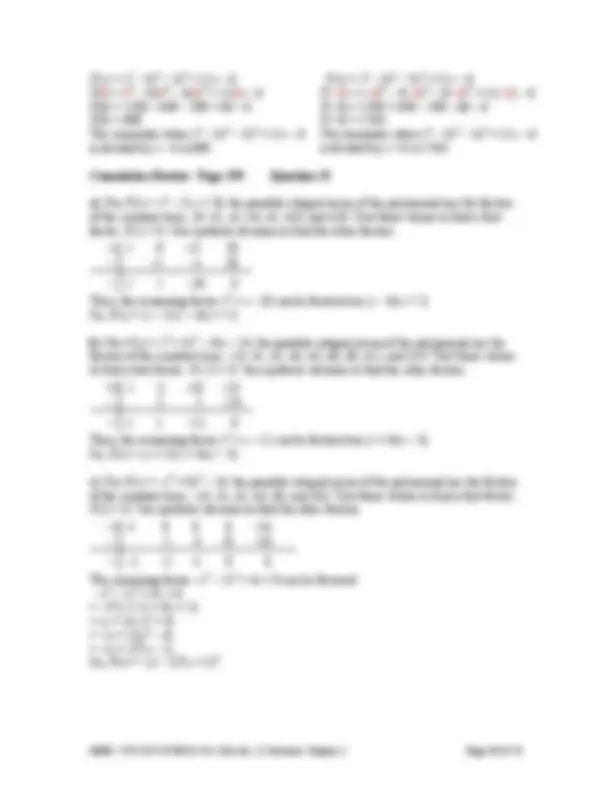
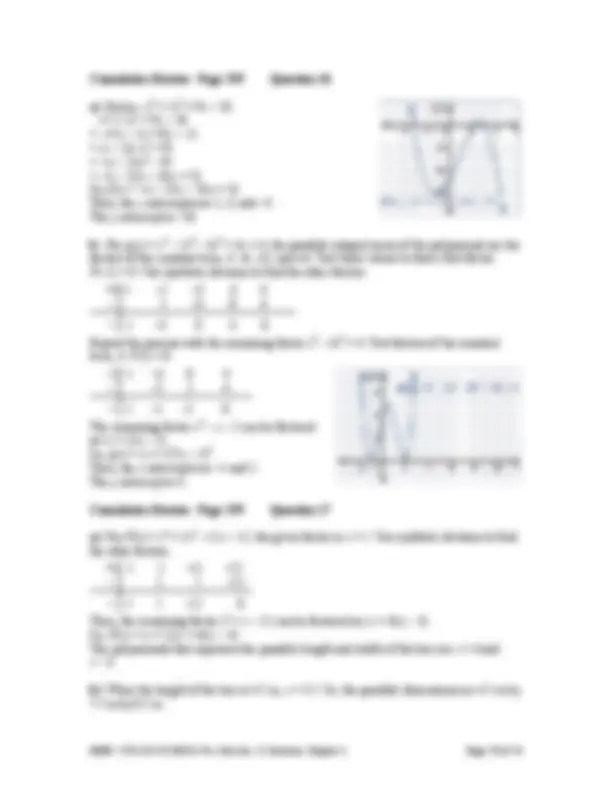
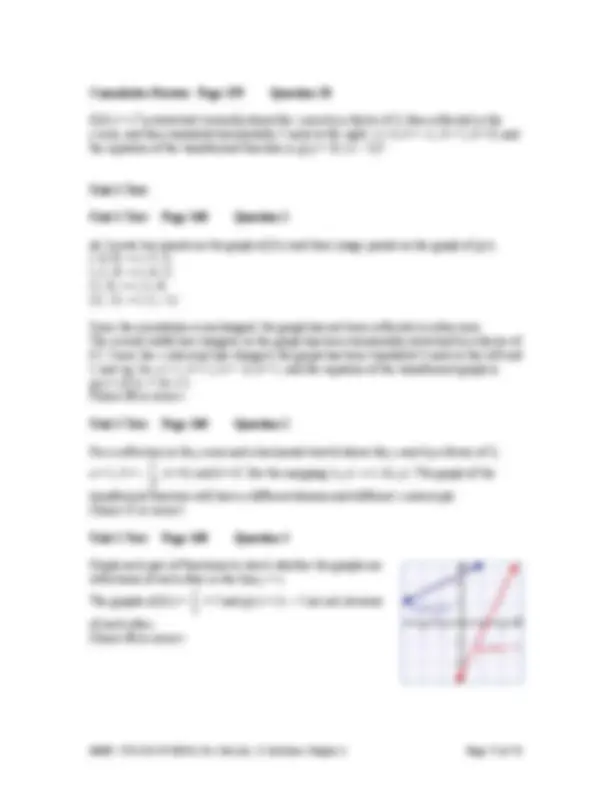

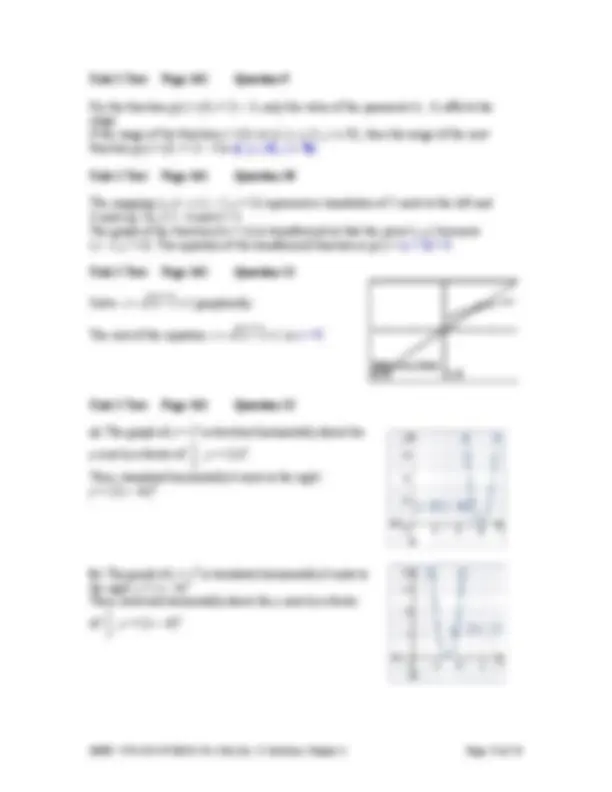
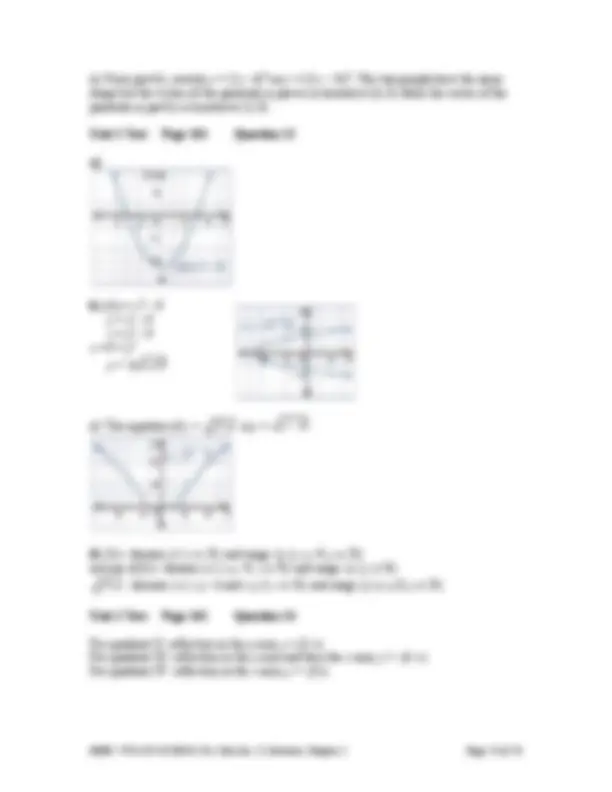
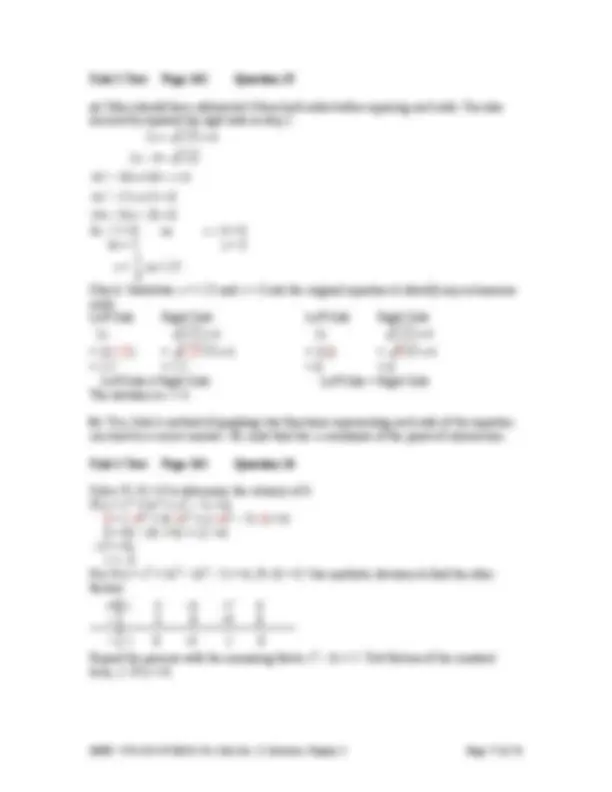
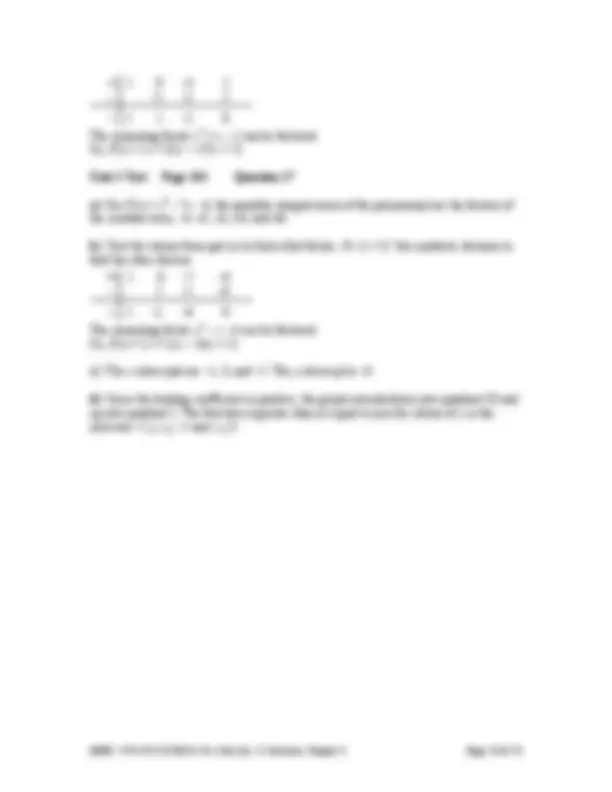


Study with the several resources on Docsity

Earn points by helping other students or get them with a premium plan


Prepare for your exams
Study with the several resources on Docsity

Earn points to download
Earn points by helping other students or get them with a premium plan
Community
Ask the community for help and clear up your study doubts
Discover the best universities in your country according to Docsity users
Free resources
Download our free guides on studying techniques, anxiety management strategies, and thesis advice from Docsity tutors
MHR • 978-0-07-0738850 Pre-Calculus 12 Solutions Chapter 3. Page 8 of 76. Section 3.1 Page 116. Question C3. Example: The line y = x and polynomial ...
Typology: Schemes and Mind Maps
1 / 76

This page cannot be seen from the preview
Don't miss anything!





































































Chapter 3 Polynomial Functions
Section 3.1 Characteristics of Polynomial Functions
Section 3.1 Page 114 Question 1
A polynomial function has the form f ( x ) = an xn^ + an – 1 x n^ – 1^ + an – 2 x n^ – 2^ + … + a 2 x^2 + a 1 x + a 0 , where an is the leading coefficient; a 0 is the constant; and the degree of the polynomial, n , is the exponent of the greatest power of the variable, x.
a) The function h ( x ) = 2 x is a radical function, not a polynomial function.
x is the same as
1 x^2 , which has an exponent that is not a whole number.
b) The function y = 3 x + 1 is of the form y = a 1 x + a 0. It is a polynomial of degree 1. The leading coefficient is 3 and the constant term is 1.
c) The function f ( x ) = 3 x^ is not a polynomial function. The variable x is the exponent.
d) The function g ( x ) = 3 x^4 – 7 is of the form g ( x ) = a 4 x^4 + a 3 x^3 + a 2 x^2 + a 1 x + a 0. It is a polynomial of degree 4. The leading coefficient is 3 and the constant term is –7.
e) The function p ( x ) = x –3^ + x^2 + 3 x is not a polynomial function. The term x –3^ has an exponent that is not a whole number.
f) The function y = –4 x^3 + 2 x + 5 is of the form g ( x ) = a 3 x^3 + a 2 x^2 + a 1 x + a 0. It is a polynomial of degree 3. The leading coefficient is –4 and the constant term is 5.
Section 3.1 Page 114 Question 2
a) The function f ( x ) = – x + 3 has degree 1; it is a linear function with a leading coefficient of –1, and a constant term of 3.
b) The function y = 9 x^2 has degree 2; it is a quadratic function with a leading coefficient of 9, and a constant term of 0.
c) The function g ( x ) = 3 x^4 + 3 x^3 – 2 x + 1 has degree 4; it is a quartic function with a leading coefficient of 3, and a constant term of 1.
d) First rewrite k ( x ) = 4 – 3 x^3 in descending powers of x : k ( x ) = –3 x^3 + 4. The function k ( x ) = –3 x^3 + 4 has degree 3; it is a cubic function with a leading coefficient of –3, and a constant term of 4.
e) The function y = –2 x^5 – 2 x^3 + 9 has degree 5; it is a quintic function with a leading coefficient of –2, and a constant term of 9.
f) The function h ( x ) = –6 has degree 0; it is a constant function with a leading coefficient of 0, and a constant term of –6.
Section 3.1 Page 114 Question 3
a) Since the graph of the function extends down into quadrant III and up into quadrant I, it is an odd-degree polynomial function with a positive leading coefficient. The graph has three x -intercepts. Its domain is { x | x R} and its range is { y | y R}.
b) Since the graph of the function extends down into quadrant III and up into quadrant I, it is an odd-degree polynomial function with a positive leading coefficient. The graph has five x -intercepts. Its domain is { x | x R} and its range is { y | y R}.
c) Since the graph of the function opens downward, extending down into quadrant III and down into quadrant IV, it is an even-degree polynomial function with a negative leading coefficient. The graph has three x -intercepts. Its domain is { x | x R} and its range is { y | y ≤ 16.9, y R}.
d) Since the graph of the function opens downward, extending down into quadrant III and down into quadrant IV, it is an even-degree polynomial function with a negative leading coefficient. The graph has no x -intercepts. Its domain is { x | x R} and its range is { y | y ≤ –3, y R}.
Section 3.1 Page 114 Question 4
a) The function f ( x ) = x^2 + 3 x – 1 is a quadratic (degree 2), which is an even-degree polynomial function. Its graph has a maximum of two x -intercepts. Since the leading coefficient is positive, the graph of the function opens upward, extending up into quadrant II and up into quadrant I, and has a minimum value. The graph has a y -intercept of –1.
b) The function g ( x ) = –4 x^3 + 2 x^2 – x + 5 is a cubic (degree 3), which is an odd-degree polynomial function. Its graph has at least one x -intercept and at most three x -intercepts. Since the leading coefficient is negative, the graph of the function extends up into quadrant II and down into quadrant IV. The graph has no maximum or minimum values. The graph has a y -intercept of 5.
c) The function h ( x ) = –7 x^4 + 2 x^3 – 3 x^2 + 6 x + 4 is a quartic (degree 4), which is an even- degree polynomial function. Its graph has a maximum of four x -intercepts. Since the leading coefficient is negative, the graph of the function opens downward, extending down into quadrant III and down into quadrant IV, and has a maximum value. The graph has a y -intercept of 4.
d) The function q ( x ) = x^5 – 3 x^2 + 9 x is a quintic (degree 5), which is an odd-degree polynomial function. Its graph has at least one x -intercept and at most five x -intercepts.
f) For 1500 snowboards, substitute x = 15. P ( x ) = 1000 x + x^4 – 3000 P (15) = 1000(15) + (15)^4 – 3000 P (15) = 62 625 The profit from the sale of 1500 snowboards is $62 625.
Section 3.1 Page 115 Question 7
a) The function r ( d ) = –3 d^3 + 3 d^2 is a cubic (degree 3).
b) The leading coefficient is –3 and the constant is 0.
c) Its graph has at least one x -intercept and at most three x -intercepts. Since the leading coefficient is negative, the graph of the function extends up into quadrant II and down into quadrant IV (similar to the line y = – x ).
d) The domain is { d | 0 ≤ d ≤ 1, d R}. Since d represents the amount of drug absorbed into the patient’s bloodstream, it must be non-negative and the reaction time must be greater than or equal to zero.
Section 3.1 Page 115 Question 8
a)
b) Substitute r = 12 into f ( r ) = 3 r^2 – 3 r + 1. f (12) = 3(12) 2 – 3(12) + 1 f (12) = 397 The total number of hexagons in a honeycomb with 12 rings is 397.
Number of Rings r
Total Number of Hexagons f ( r ) = 3 r^2 – 3 r + 1 1 1 2 7 3 19
Section 3.1 Page 116 Question 9
a) The function P ( t ) = t^4 – 20 t^3 – 20 t^2 + 1500 t + 15 000 is a quartic (degree 4), which is an even-degree polynomial function. This graph has no x -intercepts. Since the leading coefficient is positive, the graph of the function opens upward, extending up into quadrant II and up into quadrant I, and has a minimum value. The graph has a y -intercept of 15 000. For this situation, the domain is { t | 0 ≤ t ≤ 20, t R} and its range is { P | 15 000 ≤ P ≤ 37 000, P R}.
b) Currently, at t = 0, the population is 15 000 people.
c) Substitute t = 10. P ( t ) = t^4 – 20 t^3 – 20 t^2 + 1500 t + 15 000 P (10) = (10)^4 – 20(10) 3 – 20(10) 2 + 1500(10) + 15 000 P (10) = 18 000 The population of the town 10 years from now will be 18 000 people.
d) The population of the town be approximately 24 000 in 18 years from now.
Section 3.1 Page 116 Question 10
a) For this situation, the domain is { x | 0 ≤ x ≤ 20 and x ≥ 35, x R} since x , the height of each box, cannot be negative.
b) V ( x ) = 4 x^3 – 220 x^2 + 2800 x V ( x ) = 4 x ( x^2 – 55 x + 700) V ( x ) = 4 x ( x – 20)( x – 35) The factored form of the function shows that the zeros of the function are the x -intercepts of its graph.
c)
Section 3.1 Page 116 Question 13
Let a represent the root. If a polynomial equation of degree n has exactly one real root, the corresponding polynomial function is of the form y = ( x – a ) n^. If this is an even- degree function, then its graph will only touch the x -axis. If this is an odd-degree function, then its graph will cross the x -axis once.
Section 3.1 Page 116 Question C
Let n represent the degree of the polynomial function. Let a represent the maximum or minimum value. Characteristic Odd Degree Even Degree
Number of x -intercepts minimum of 1 and maximum of n maximum of n
Number of maximum and minimum points none minimum point when an > 0, maximum point when an < 0 Domain (^) { x | x R} { x | x R}
Range (^) { y | y R} { y^ |^ y^ ≥^ a ,^ y^ ^ R}, { y | y ≤ a , y R}
Section 3.1 Page 116 Question C
a) i) A graph that extends from quadrant III to I is an odd-degree function with a positive leading coefficient. For example, y = x^3 or y = 3 x^3 + 5.
ii) A graph that extends from quadrant II to I is an even-degree function with a positive leading coefficient. For example, y = x^4 or y = 2 x^4 + 1.
iii) A graph that extends from quadrant II to IV is an odd-degree function with a negative leading coefficient. For example, y = – x^3 or y = –3 x^3 + 5.
iv) A graph that extends from quadrant III to IV is an even-degree function with a negative leading coefficient. For example, y = – x^4 or y = –2 x^4 + 1.
b) Answers should agree on even or odd degree and on the sign of the leading coefficient.
Section 3.1 Page 116 Question C
Example: The line y = x and polynomial functions with odd degree greater than one and positive leading coefficient extend from quadrant III to quadrant I. Both have no maximum or minimum value. Both have the same domain and range. While the graph of y = x has only one x -intercept, the graph of an odd-degree polynomial function can have one, two, or three x -intercepts.
Section 3.1 Page 117 Question C
Step 1 Linear and Quadratic Cubic
Quartic Quintic
Function Degree End Behaviour y = x + 2 1 extends from quadrant III to I y = –3 x + 1 1 extends from quadrant II to IV y = x^2 – 4 2 opens upward y = –2 x^2 – 2 x + 4 2 opens downward y = x^3 – 4 x 3 extends from quadrant III to I y = – x^3 + 3 x – 2 3 extends from quadrant II to IV y = 2 x^3 + 16 3 extends from quadrant III to I y = – x^3 – 4 x 3 extends from quadrant II to IV y = x^4 – 4 x^2 + 5 4 opens upward y = – x^4 + x^3 + 4 x^2 – 4 x 4 opens downward y = x^4 + 2 x^2 + 1 4 opens upward y = x^5 – 2 x^4 – 3 x^3 + 5 x^2 + 4 x – 1 5 extends from quadrant III to I y = x^5 – 1 5 extends from quadrant III to I
Section 3.2 Page 124 Question 2
a) 3 2 4 3 2 4 3 3 2 3 2
2 2
x x x x x x x x x x x x x x
x x x x x x
4 3 2 3 4 6 17 8 3 3 7 2 16 24 1 1
x x x x x x x x x
b) The restriction is x ≠ –1.
c) The corresponding statement that can be used to check the division is ( x + 1)(3 x^3 – 7 x^2 + x + 16) – 24 = 3 x^4 – 4 x^3 – 6 x^2 + 17 x – 8.
d) ( x + 1)(3 x^3 – 7 x^2 + x + 16) – 24 = 3 x^4 – 7 x^3 + x^2 + 16 x + 3 x^3 – 7 x^2 + x + 16 – 24 = 3 x^4 – 4 x^3 – 6 x^2 + 17 x – 8
Section 3.2 Page 124 Question 3
a) For ( x^3 + 3 x^2 − 3 x − 2) ÷ ( x − 1), the quotient, Q , is x^2 + 4 x + 1. 2 3 2 3 2 2 2
x x x x x x x x x x x x x x
b) For
x x x x
, the quotient, Q , is
x^2 + 4 x + 1. 2 3 2 3 2 2 2
x x x x x x x x x x x x x x
c) For (2 w^3 + 3 w^2 − 5 w + 2) ÷ ( w + 3), the quotient, Q , is 2 w^2 – 3 w – 4. 2 3 2 3 2 2 2
w w w w w w w w w w w w w w
d) For (9 m^3 − 6 m^2 + 3 m + 2) ÷ ( m − 1), the quotient, Q , is 9 m^2 + 3 m + 6. 2 3 2 3 2 2 2
m m m m m m m m m m m m m m
e) For
t t t t t
, the quotient,
Q , is t^3 + 5 t^2 – 8 t + 7. 3 2 4 3 2 4 3 3 2 3 2
2 2
t t t t t t t t t t t t t t t t t t t t
f) For (2 y^4 − 3 y^2 + 1) ÷ ( y − 3), the quotient, Q , is 2 y^3 + 6 y^2 + 15 y + 45. 3 2 4 3 2 4 3 3 2 3 2 2 2
y y y y y y y y y y
y y y y
y y y y y y
Section 3.2 Page 124 Question 4
a) For ( x^3 + x^2 + 3) ÷ ( x + 4), the quotient, Q , is x^2 – 3 x + 12. b)^ For
m m m m m
, the
quotient, Q , is m^3 + m + 14. –2 1 –2 1 12 –
× 1 0 1 14 22
Section 3.2 Page 124 Question 6
Evaluate P (–2). a) P ( x ) = x^3 + 3 x^2 − 5 x + 2 P (−2) = (−2) 3 + 3(−2) 2 − 5(−2) + 2 P (−2) = −8 + 12 + 10 + 2 P (−2) = 16 The remainder when x^3 + 3 x^2 − 5 x + 2 is divided by x + 2 is 16.
b) P ( x ) = 2 x^4 − 2 x^3 + 5 x P (−2) = 2(−2) 4 – 2(−2)^3 + 5(−2) P (−2) = 32 + 16 – 10 P (−2) = 38 The remainder when 2 x^4 − 2 x^3 + 5 x is divided by x + 2 is 38.
c) P ( x ) = x^4 + x^3 − 5 x^2 + 2 x − 7 P (−2) = (−2) 4 + (−2) 3 – 5(−2) 2 + 2(−2) – 7 P (−2) = 16 – 8 – 20 – 4 – 7 P (−2) = – The remainder when x^4 + x^3 − 5 x^2 + 2 x – 7 is divided by x + 2 is –23.
d) P ( x ) = 8 x^3 + 4 x^2 − 19 P (−2) = 8(−2) 3 + 4(−2)^2 – 19 P (−2) = –64 + 16 – 19 P (−2) = – The remainder when 8 x^3 + 4 x^2 − 19 is divided by x + 2 is –67.
e) P ( x ) = 3 x^3 – 12 x − 2 P (−2) = 3(−2) 3 – 12(−2) – 2 P (−2) = –24 + 24 – 2 P (−2) = – The remainder when 3 x^3 – 12 x^ −^ 2 is divided by^ x^ + 2 is –2.
f) P ( x ) = 2 x^3 + 3 x^2 − 5 x + 2 P (−2) = 2(−2) 3 + 3(−2)^2 – 5(−2) + 2 P (−2) = –16 + 12 + 10 + 2 P (−2) = 8 The remainder when 2 x^3 + 3 x^2 − 5 x + 2 is divided by x + 2 is 8.
Section 3.2 Page 124 Question 7
a) Evaluate^ P (–3). P ( x ) = x^3 + 2 x^2 − 3 x + 9 P (–3) = (–3)^3 + 2(–3)^2 − 3(–3) + 9 P (–3) = –27 + 18 + 9 + 9 P (–3) = 9 The remainder when x^3 + 2 x^2 −^3 x^ + 9 is divided by^ x^ + 3 is 9.
b) Evaluate P (2). P ( t ) = 2 t – 4 t^3 – 3 t^2 P (2) = 2(2) – 4(2) 3 – 3(2) 2 P (2) = 4 – 32 – 12 P (2) = – The remainder when 2 t – 4 t^3 – 3 t^2 is divided by t – 2 is –40.
c) Evaluate P (3). P ( x ) = x^3 + 2 x^2 − 3 x + 5 P (3) = (3) 3 + 2(3) 2 − 3(3) + 5 P (3) = 27 + 18 – 9 + 5 P (3) = 41 The remainder when x^3 + 2 x^2 − 3 x + 5 is divided by x – 3 is 41.
d) Evaluate P (2). P ( n ) = n^4 – 3 n^2 – 5 n + 2 P (2) = (2) 4 – 3(2) 2 – 5(2) + 2 P (3) = 16 – 12 – 10 + 2 P (3) = – The remainder when n^4 – 3 n^2 – 5 n + 2 is divided by n – 2 is –4.
Section 3.2 Page 124 Question 8
a) Solve P (1) = 3 to determine the value of k. P ( x ) = x^3 + 4 x^2 − x + k 3 = 1^3 + 4(1) 2 − 1 + k 3 = 1 + 4 – 1 + k k = –
b) Solve P (2) = 3 to determine the value of k. P ( x ) = x^3 + x^2 + kx – 15 3 = 2^3 + 2^2 + k (2) – 15 3 = 8 + 4 + 2 k – 15 k = 3
c) Solve P (–2) = 3 to determine the value of k. P ( x ) = x^3 + kx^2 + x + 5 3 = (–2) 3 + k (–2)^2 + (–2) + 5 3 = –8 + 4 k – 2 + 5 k = 2
Section 3.2 Page 125 Question 12
a) Determine 2 n^2 – 4 n + 3 ÷ n – 3.
An expression for the other real number is 2 n + 2 +
n 3
b) For n = 1:
n 3 1 3
n n
For n = 1, the two numbers are –2 and –0.5.
Section 3.2 Page 125 Question 13
a) Use synthetic division.
The expression 9π x^2 + 24π x + 16π represents the area of the base of the cylindrical containers.
b) V ( x ) = (9π x^2 + 24π x + 16π)( x + 3) V ( x ) = π(9 x^2 + 24 x + 16)( x + 3) V ( x ) = π(3 x + 4) 2 ( x + 3) V = π r^2 h In this factored form, 3 x + 4 represents the radius, r , and x + 3 represents the height, h.
c) If 2 ≤ x ≤ 8, then 10 ≤ r ≤ 28 and 5 ≤ h ≤ 11. For the given values of x , the radius can be from 10 cm to 28 cm and the height can be from 5 cm to 11 cm.
Section 3.2 Page 125 Question 14
Solve a system of equations represented by P (–3) = –1 and P (2) = –4. P ( x ) = mx^3 − 3 x^2 + nx + 2 P ( x ) = mx^3 − 3 x^2 + nx + 2 –1 = m (–3) 3 − 3(–3) 2 + n (–3) + 2 –4 = m (2) 3 − 3(2) 2 + n (2) + 2 –1 = –27 m − 27 – 3 n + 2 –4 = 8 m − 12 + 2 n + 2 24 = –27 m − 3 n 6 = 8 m + 2 n 8 = –9 m – n 3 = 4 m + n
+3 9 π 51 π 88 π 48 π
× 9 π^24 π^16 π^0
27 π 72 π 48 π
Add equations and : 11 = –5 m
m =
Substitute m =
into equation :
n
n
Section 3.2 Page 125 Question 15
Solve a system of equations represented by P (2) = –5 and P (–1) = –16. P ( x ) = 3 x^3 + ax^2 + bx − 9 P ( x ) = 3 x^3 + ax^2 + bx − 9 –5 = 3(2) 3 + a (2) 2 + b (2) – 9 –16 = 3(–1)^3 + a (–1)^2 + b (–1) – 9 –5 = 24 + 4 a + 2 b – 9 –16 = –3 + a – b – 9 –20 = 4 a + 2 b –4 = a – b –10 = 2 a + b Add equations and : –14 = 3 a
a =
Substitute a =
into equation :
b
b
Section 3.2 Page 125 Question 16
To determine the remainder when 10 x^4 − 11 x^3 − 8 x^2 + 7 x + 9 is divided by 2 x – 3, using
synthetic division, rewrite the binomial as x –
, or x – 1.5.
The remainder is 15.
Section 3.2 Page 125 Question 17
Examples: a) A quadratic polynomial that gives P (3) = –4 is P ( x ) = ( x – 1)( x – 3) – 4, or P ( x ) = x^2 – 4 x – 1.
b) A cubic polynomial that gives P (–2) = 4 is P ( x ) = ( x – 1) 2 ( x + 2) + 4, or P ( x ) = x^3 – 3 x + 6.
Section 3.3 The Factor Theorem
Section 3.3 Page 133 Question 1
a) If P (1) = 0, then a corresponding binomial factor of a polynomial, P ( x ), is x – 1.
b) If P (–3) = 0, then a corresponding binomial factor of a polynomial, P ( x ), is x + 3.
c) If P (4) = 0, then a corresponding binomial factor of a polynomial, P ( x ), is x – 4.
d) If P ( a ) = 0, then a corresponding binomial factor of a polynomial, P ( x ), is x – a.
Section 3.3 Page 133 Question 2
a) Evaluate P (1). P ( x ) = x^3 − 3 x^2 + 4 x − 2 P (1) = (1) 3 – 3(1) 2 + 4(1) – 2 P (1) = 1 – 3 + 4 – 2 P (1) = 0 Since the remainder is zero, x – 1 is a factor of P ( x ).
b) Evaluate P (1). P ( x ) = 2 x^3 − x^2 − 3 x − 2 P (1) = 2(1) 3 – (1) 2 – 3(1) – 2 P (1) = 2 – 1 – 3 – 2 P (1) = – Since the remainder is not zero, x – 1 is not a factor of P ( x ).
c) Evaluate P (1). P ( x ) = 3 x^3 − x − 3 P (1) = 3(1) 3 – (1) 2 – 3 P (1) = 3 – 1 – 3 P (1) = – Since the remainder is not zero, x – 1 is not a factor of P ( x ).
d) Evaluate P (1). P ( x ) = 2 x^3 + 4 x^2 − 5 x − 1 P (1) = 2(1) 3 + 4(1) 2 – 5(1) – 1 P (1) = 2 + 4 – 5 – 1 P (1) = 0 Since the remainder is zero, x – 1 is a factor of P ( x ).
e) Evaluate P (1). P ( x ) = x^4 − 3 x^3 + 2 x^2 − x + 1 P (1) = (1) 4 – 3(1) 3 + 2(1)^2 – 1 + 1 P (1) = 1 – 3 + 2 – 1 + 1 P (1) = 0
Since the remainder is zero, x – 1 is a factor of P ( x ).
f) Evaluate P (1). P ( x ) = 4 x^4 − 2 x^3 + 3 x^2 − 2 x + 1 P (1) = 4(1) 4 – 2(1) 3 + 3(1) 2 – 2(1) + 1 P (1) = 4 – 2 + 3 – 2 + 1 P (1) = 4 Since the remainder is not zero, x – 1 is not a factor of P ( x ).
Section 3.3 Page 133 Question 3
a) Evaluate P (–2). P ( x ) = 5 x^2 + 2 x + 6 P (–2) = 5(–2) 2 + 2(–2) + 6 P (–2) = 20 – 4 + 6 P (–2) = 22 Since the remainder is not zero, x + 2 is not a factor of P ( x ).
b) Evaluate P (–2). P ( x ) = 2 x^3 − x^2 − 5 x − 8 P (–2) = 2(–2) 3 – (–2) 2 – 5(–2) – 8 P (–2) = –16 – 4 + 10 – 8 P (–2) = – Since the remainder is not zero, x + 2 is not a factor of P ( x ).
c) Evaluate P (–2). P ( x ) = 2 x^3 + 2 x^2 − x − 6 P (–2) = 2(–2) 3 + 2(–2) 2 – (–2) – 6 P (–2) = –16 + 8 + 2 – 6 P (–2) = – Since the remainder is not zero, x + 2 is not a factor of P ( x ).
d) Evaluate P (–2). P ( x ) = x^4 − 2 x^2 + 3 x − 4 P (–2) = (–2)^4 – 2(–2) 2 + 3(–2) – 4 P (–2) = 16 – 8 – 6 – 4 P (–2) = – Since the remainder is not zero, x + 2 is not a factor of P ( x ).
e) Evaluate P (–2). P ( x ) = x^4 + 3 x^3 − x^2 − 3 x + 6 P (–2) = (–2)^4 + 3(–2)^3 – (–2) 2 – 3(–2) + 6 P (–2) = 16 – 24 – 4 + 6 + 6 P (–2) = 0 Since the remainder is zero, x + 2 is a factor of P ( x ).